Blog
The Top 5 Business Concerns for 2025 (Plus a Newly Emerging Risk) 
6-minute read
For the past two years, we’ve turned to the Allianz Risk Barometer to uncover the biggest threats businesses face. This annual report from global insurer Allianz Group highlights the key concerns and emerging challenges shaping the year ahead.
Today, we look into the five biggest concerns keeping business leaders up at night – plus one rising challenge on the horizon. Understanding these risks can help companies prepare for what lies ahead.
Breach of Biosecurity: $42,500 Fine for Quarantine Violation 
2-minute read
A Christchurch nursery and its director have been fined $42,500 for breaching New Zealand’s biosecurity regulations by illegally removing hundreds of imported plants from quarantine.
Your Shipping Costs Rise Again: What You Need to Know 
5-minute read
The cost of shipping goods has once again surged, posing challenges for businesses and consumers worldwide.
As customs brokers, we stay informed about market developments, ensuring our clients are well-prepared for these changes.
Did You Know? Where Cargo is Unpacked Matters for Biosecurity 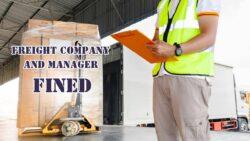
3-minute read
An international freight company based in Auckland and its logistics manager have been collectively fined over $28,000 for breaching biosecurity regulations.
The charges stem from their failure to conduct mandatory biosecurity checks and their transportation of 15 sea containers to unauthorized locations for unpacking.
Global Container Port Rankings: Latest Performance Index 
3-minute read
If you’ve ever wondered how ports rank globally, the latest Container Port Performance Index (CPPI) report by the World Bank and S&P Global Market Intelligence offers valuable insights.
While port performance can be evaluated using various metrics—such as terminal capacity, space utilization, cost, landside connectivity and services, and ship-to-shore interchange—the CPPI report specifically measures the time a vessel spends in port.
Is It Worth Having Marine Cargo Insurance? 
3-minute read
In the world of maritime commerce, unexpected events like the recent Baltimore bridge collapse involving the Dali box ship can have profound implications for cargo owners.
Strong Start to 2024: Airfreight Thrives Amid Shipping Delays 
2-minute read
Amidst disruptions in the Red Sea, the reliability of ocean shipping schedules took a significant hit in January, dropping to just 39.4%, marking the lowest point since October 2022, according to a report by Sea Intelligence cited by the Loadstar.
Consequently, shippers are increasingly turning to sea-air or airfreight alternatives to navigate the challenges posed by the crisis.
Seize the Digital Opportunity: Insights for Online Retailers 
4-minute read
Consumer behaviour is changing, urging businesses to understand evolving preferences, habits, and expectations in the digital era.
The pandemic has expedited this shift, particularly in tech-driven interactions.
Impact of Red Sea Crisis on New Zealand’s Trade Route 
4-minute read
Amidst the ongoing conflict in Gaza and Houthi rebel attacks in the Red Sea, a substantial impact on global shipping is unfolding.
As vessels steer away from the conflict zone, opting for a lengthier journey around Africa to avoid the Suez Canal, freight costs soar, and transit times extend.
Key Global Business Risks and Growing Cyber Threats in 2024 
4-minute read
The evolving landscape of global business risks is front and centre in the Allianz Risk Barometer 2024, which sheds light on the most pressing challenges faced by companies worldwide.
According to the Allianz recent survey on business risks, the main problems companies are facing worldwide right now are digitalization, climate change, and uncertain global politics.
What’s Happening in the Air Freight Market 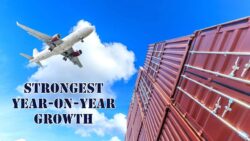
3-minute read
The International Air Transport Association (IATA) released data for November 2023 global air cargo markets, indicating the strongest year-on-year growth in roughly two years.
This is partly due to weakness in November 2022 but also reflects a fourth consecutive month of strengthening demand for air cargo.
Sailing Through Uncertainty: Current Global Shipping Challenges 
8-minutes to read
The crisis in the Suez Canal is causing significant disruptions in global supply chains, with container ships having to re-route around the Cape of Good Hope to avoid Houthi terrorist threats near the Bab al-Mandab Strait, resulting in a considerable impact on the operational capacity of the global container fleet.
Seamless Borders: New Zealand Customs’ 2023 Time Release Study 
3-minute read
New Zealand Customs shared what they learned in their 2023 Time Release Study. Let’s look into how they clear cargo quickly, showing their dedication to making international trade fast and effective.
A Time Release Study (TRS) is a World Customs Organization method of measuring Customs’ performance in clearing cargo moving across the border, measuring the times of various events and procedures from arrival to release to market.
Are You Importing Building Products into NZ? 
3-minute read
If you are importing building products into NZ, be sure to know New Building Product Information Requirements.
On 11 December 2023, new regulations for building product information requirements will commence.
A Glimpse into the Fully Digital Future Air Travel 
3-minute read
At the end of last year, we shared in our blog that the International Air Transport Association (IATA) developed industry standards to digitalize passenger experience at airports.
These standards involve contactless biometric processes, which will bring the aim of having travellers arrive at airports ready-to-fly one step closer to reality.
Recently, IATA, with industry partners, successfully tested the first fully integrated digital identity travel experience, from shopping for flights to arrival on a journey from London Heathrow (LHR) to Rome Fiumicino (FCO) with British Airways.
“Our vision for future travel is fully digital and secured with biometric identification. While the technology exists to do this at each stage of a journey, linking these steps together has proven challenging. Today with our partners we showed that it is possible. This will open up a world of possibilities for simpler journeys in the future,” said Nick Careen, IATA’s Senior Vice President for Operations, Safety and Security.
According to IATA, the trial journey illustrated the potential of a future fully integrated digital travel experience leveraging biometrics with:
Personalized Offers
This will be seen from the shopping experience, where travellers will be able to receive personalized offers through all shopping channels. The LHR-FCO passenger shared their loyalty card data (stored as a verifiable credential in their smart phone’s digital wallet) with a travel agent.
This enabled airlines to use the new IATA’s data exchange programme to make personalized offers through the travel agent channel.
Simplified Orders
Once the traveller has chosen among the offers, an order is generated as a verifiable credential that can be stored in a digital wallet.
No more Passenger Name Records, e-tickets or electronic miscellaneous documents are needed.
All the information about the journey is stored in the verifiable credential, which can also be read as a QR code.

Effortless Travel Requirements Check
Many processes can be done long before the traveller gets to the airport.
Along with the digital wallet, a digital passport (stored in the traveller’s digital wallet) will be a key enabler.
By sharing the nationality data of the digital passport, passengers can confirm their travel document requirements. IATA has a solution to support real-time information on travel document requirements for international air travel.
“Ready to Fly” – Simplifying and Securing Check-ins
The LHR-FCO traveller also chose to share their digital passport and order data with their airline, British Airways, to receive a confirmation that they are Ready-to-Fly and seat assignment via text message, being spared from manual data input.
Traditional boarding passes may become optional if travellers are offered and accept a contactless experience at the airport.
Contactless Airport Experiences
For travellers who choose to share their biometric data, storing your phone and proceeding hands-free (with your phone and your passport in your pocket or purse) through the airport will be possible.
Biometric gates cleared the way for the LHR-FCO traveller through security, into lounges and onto the aircraft.
“As an airline, we are always innovating and looking at ways to make the customer journey as seamless as possible. We introduced biometric boarding on selected flights earlier this year and it has been a huge success with positive customer feedback. Working with IATA on enabling a fully integrated travel journey helps us build on that and shows us what could be possible in the future,” said Dirk John, British Airways Chief Information and Digital Officer.
The full paper about the end-to-end journey using Digital Identity can be found here
Source: International Air Transport Association (IATA)
On a side note, in New Zealand, the NZ Customs authorities have recently conducted trials involving digital declarations as an alternative to conventional paper arrival cards.
These digital declarations are seamlessly integrated with travellers’ passports and are automatically processed upon their arrival in New Zealand.
The successful outcome of these trials has led to the implementation of this technology, offering travellers arriving at all New Zealand international airports the choice to complete a digital declaration instead of a traditional paper arrival card before their journey to the country.
P.S. Easy Freight Ltd helps New Zealand importers & exporters to save money on international freight and reduce mistakes by guiding how to comply with Customs and biosecurity rules.
➔ Contact us now to learn how we can assist you
How Auckland Port Price Increases Will Affect Importers 
3-minute read
The Port of Auckland has revealed a general price increase of 7% starting from January 1, 2024.
Furthermore, new surcharges for commercial port users will be implemented as of March 1, 2024.
Food Labelling Compliance Alert: New Regulations Impacting Food Imports 
3-minute read
Recently, Auckland-based importers of food products were fined a total of NZ$28,000 for their failure to translate food allergen declarations into English.
New Zealand Food Safety introduced stronger requirements for all food importers in the country. These changes clarify the responsibilities of food importers when bringing products into New Zealand to guarantee the safety and suitability of food for local consumers.
How EU Emissions Trading Scheme Affects NZ Importers and Exporters 
2-minute read
From 1 January 2024, the EU Emissions Trading Scheme (EU ETS) will be extended to cover CO2 (carbon dioxide) emissions from all large ships (of 5000 gross tonnage and above) entering EU ports, regardless of the flag those ships fly.
Why Domestic Transport Costs Continue to Rise 
3-minute read
The recent announcement of price increases by the Port of Auckland (POAL) is part of an ongoing series of hikes that are affecting the road transport industry, according to the National Road Carriers (NRC).
The NRC highlights that the industry is facing substantial increases in various cost factors, which is putting the sustainability of many carriers at risk. Justin Tighe-Umbers, the CEO of NRC, emphasizes that domestic freight charges are inevitably rising due to these escalating costs.
The Journey of Your Package: Behind the Scenes with NZ Customs and Biosecurity 
4-minute read (4-minute watch)
Ever wondered where your package goes on its journey to you?
Well, it’s quite a team effort involving several companies. If you want to track down your parcel, you’ll need to connect with either New Zealand Post, the courier, fast freight or the shipping company responsible for sending it.
What’s on the Horizon for NZ Freight and Supply Chain Sector 
6-minute read
Te Manatū Waka (Ministry of Transport) has introduced its first-ever national strategy for freight and supply chain management, with the intention of boosting the efficiency and robustness of New Zealand’s ports, shipping, and freight sectors.
What NZ Supply Chain Business Leaders Say 
5-minute read
Anticipated in the coming 12 months, the “Mid-Year 2023 New Zealand Supply Chain and Logistics Risks Outlook” reveals an increasing likelihood of encountering issues related to cyber-attacks and financial vulnerabilities.
Upgraded Verification to Assist Trade with China 
3-minute read
Trading with China is set to become easier for New Zealand exporters with the addition of a self-certification option with the General Administration of Customs of the People’s Republic of China (China Customs).
LCL: Understanding Less than Container Load Shipping 
2-minute read
As a small business owner, it’s important to understand different shipping options available to efficiently move your products internationally.
Sometimes, the challenge of international logistics can be discouraging for small businesses that lack sufficient cargo to fill an entire container.
The Explosive Risks of the Lithium Battery Trade 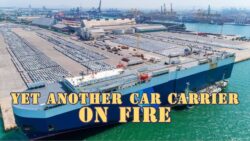
4-minute read
Another car carrier disaster has occurred, with electric vehicle batteries being identified as the possible cause of the fire.
This tragic incident resulted in the loss of a seafarer’s life and caused injuries to others. As a result, safety concerns are being heightened not only due to the fire itself but also due to the possible involvement of electric vehicle batteries in the accident.
New Zealand Arrival Card Goes Digital: What You Need to Know 
3-minute read
UPDATE: October 2023
Travellers arriving into all New Zealand international airports now have the option to complete a digital declaration instead of a paper arrival card before travelling to New Zealand.
When to Consider a 3PL for Your Business 
3-minute read
You import and sell products online, and you find that your small e-commerce business has experienced significant growth to the point where you struggle to keep up with customer orders and manage inventory.
It may be time to consider a solution that allows you to focus on networking and expanding your business while leaving the logistics to professionals.
This is where Third-Party Logistics (3PL) comes into play.
Airline Industry Profitability Outlook for 2023 
5-minute read
The International Air Transport Association (IATA) announced an expected strengthening of airline industry profitability in an upgrade of its outlook for 2023.
Clean Car Standard Changes from 1 June 2023 
5-minute read
If you are someone importing light vehicles into New Zealand on a Clean Car Standard Pay As You Go scheme, read this article to understand what you need to do to make payments and use credits from the 1st of June, 2023.
Customs Number or Client Code: What Is It and Do You Need It? 
2-minute read
Did you know that if you’re planning on bringing items into NZ (importing) or sending items overseas (exporting) that are worth over NZ$1000, you need to apply for a Customs Number or a Client Code with New Zealand Customs Service?
Food Importers Must Know: Country of Origin of Food 
6-minute read
Importers of frozen food and their agents are reminded that the Origin of Food Regulations that apply to certain frozen food came into effect on 12 May 2023.
Decline in Air Cargo Continues While Air Travel Grows 
4-minute read
The International Air Transport Association (IATA) released data for March 2023 showing that global air cargo markets continue to decline against the previous year’s demand performance. This trend began in March 2022.
Update on Global Supply Chains and Latest China Market Trends 
8-minute read
New Zealand’s Ministry of Foreign Affairs and Trade have been monitoring global supply chain disruptions and developments since June 2020.
In this article, we bring you global supply chain trends, including improvements in sea freight and recovering air connectivity, according to MFAT’s latest market intelligence report.
Do You Need to Pay Customs Duties and GST on Temporary Imports? 
6-minute read
Sometimes you are importing goods that you’ll be exporting again. If they aren’t consumable and will be in NZ for less than a year, New Zealand Customs calls them “temporary imports”.
You may not have to pay Customs duties and GST on temporary imports.
What You Need to Know Before Importing Food into New Zealand 
5-minute read
To import food into New Zealand for sale, individuals need to understand and comply with the requirements under the Food Act 2014. Ministry for Primary Industries has developed guides to help you comply with the process.
Here we look at the steps you will need to complete to successfully register and import food into New Zealand.
Selling online? Do You Know What Your Customers Value the Most? 
5-minute read
COVID-19 has fundamentally changed the way businesses operate, most notably in online trading.
NZ Couriers published Ecommerce Insights: Merchant 2023 Report that provides insight into what e-commerce means for customers as the modern-day business has transformed over the past decade, and nearly half of all Kiwi businesses reporting an increase in online trading since the start of the pandemic.
Project Fly Net Zero – IATA Update 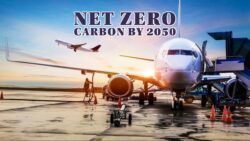
4-minute read
The International Air Transport Association (IATA) issued an update on the ongoing and exciting developments across the air transport industry on the journey to Fly Net Zero.
Air Cargo Makes a Soft Start to 2023 
3-minute read
The International Air Transport Association (IATA) released data for January 2023 on global air cargo markets showing that air cargo demand declined as economic headwinds persist.
How Quickly Imports and Exports are Cleared by Customs in New Zealand – Time Release Study 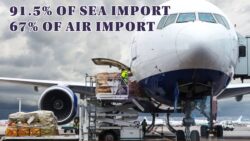
3-minute read
Customs clearance of cargo is a significant activity in facilitating and holding up trade at the border.
The New Zealand Customs Service has published its latest Time Release Study (TRS), which looks at how quickly imports and exports are cleared in New Zealand.
The Debate Around Moving Auckland Port 
9-minute read (18-minute listen)
While many Aucklanders would love to see the cars and containers go, the scale of moving the Ports of Auckland has made for a contentious debate.
So what would be involved in moving the port? Should it happen? And how long until Aucklanders get a waterfront with a view?
Identifying the Major Business Risks for 2023 
6-minute read
Today we look at the most important business concerns for companies worldwide for 2023.
Inflationary pressures, energy prices, climate change, digitalization, and geopolitical uncertainty test already strained business models and supply chains, according to the Allianz Risk Barometer, which complied responses from 2,712 risk management experts from a record 94 countries.
China’s Abandonment of Zero COVID Policy and What It Means for Importers and Exporters 
10-minute read
Today we’re looking at that strange time of shipping and logistics year when traditionally, ahead of factory closures for the Chinese New Year holidays, we see a spike in air and ocean demand and freight rates.
But will tradition mean a thing in 2023? How long will factories stay closed?
And what does the unwinding of China’s zero COVID policy mean for manufacturers, international travel, air cargo and shipping supply chains, both in the coming weeks and in the year ahead?
The Challenges of a Post-Covid World for Global Supply Chains 
9-minute read
If 2022 taught us anything, it was to expect the unexpected. It was the year that shocked us with the war in Ukraine, endless Chinese Covid lockdowns, soaring inflation and the devastation of tighter fiscal and monetary policies.
Extreme weather affected supply chains from India to the Mississippi and Australia to the Rhine. Freight rates collapsed, and the peak season was a non-event.
Arriving at the Airport ‘Ready to Fly’ is Closer to Reality with New Industry Standards 
3-minute read
The International Air Transport Association (IATA) has developed industry standards which will bring the aim of having travellers arrive at airports ready-to-fly one step closer to reality.
The newly released Recommended Practice on Digitalization of Admissibility will enable travellers to digitally prove admissibility to an international destination, avoiding a stop at the check-in desk or boarding gate for document checks.
Reducing Container Volumes, Declining Freight Rates, Excess Capacity – the Current State of Global Supply Chain 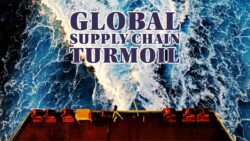
6-minute read
The global economic outlook appears to be deteriorating further amid slowing growth and elevated inflation levels, comments Danish shipping and logistics group A.P. Moller-Maersk.
As a result, global container volumes continue to fall with negative growth in virtually all the main markets.
5 Claims Trends to Watch in Marine Insurance 
8-minute read
The long-term positive safety trend for the global shipping industry continues as total losses have more than halved over the past decade.
However, a number of factors are leading to ever-larger claims, according to an industry loss analysis report by insurers Allianz Global Corporate & Specialty (AGCS), who summed up the 5 claims trends to watch in marine insurance based on their findings.
How to Determine the Customs Value for Your Imported Items 
5-minute read
When goods are transported across international borders, a tariff duty can be levied on imported goods either as a percentage of the monetary value of the goods (ad valorem), a specific rate of duty (e.g. $1 per litre of alcohol), or a combination of ad valorem plus a specific rate of duty.
Most countries calculate tariff duty on an ad valorem basis (a percentage of the value) as it is more equitable, transparent and easier to estimate.
However, the amount of duty payable depends on the value of the imported goods.
The Dangers of Transporting EVs with Lithium-ion Batteries Along the Supply Chain 
6-minute read
Today, lithium-ion (or “Li-ion”) batteries are an essential everyday item found throughout the world and in almost every household or workplace in one form or another.
They are found in portable devices such as mobile phones, mobility devices, recreation, manufacturing and power storage, through to larger products, such as electric vehicles (scooters, bicycles, cars, buses and trucks) and even superyachts and ships.
Global Air Cargo Activities are Declining while Air Passenger Traffic is Strong 
3-minute read
The International Air Transport Association (IATA) released data for September 2022 global air cargo markets showing that air cargo demand softened.
What You Need to Know About the Latest Trade Sanctions 
3-minute read
Importers, exporters and their agents are reminded that a wide range of goods of any origin are prohibited from export to the Russian Federation or from import to New Zealand if their country of origin was the Russian Federation from 4 November 2022.
Clean Car Programme for Importing Vehicles into New Zealand 
5-minute read
The Clean Car Standard (CCS) and the Clean Car Discount (CCD) form the central pillars of a range of government initiatives to tackle transport sector CO2 emission levels and help address climate change.
The Climate Change Response (Zero Carbon) Amendment Act 2019 requires CO2 emissions to be reduced to net zero by 2050. As transport is responsible for 47 percent of the domestic CO2 in New Zealand, this target cannot be achieved without decarbonising transport.
Does New Zealand Have an Empty Depot Problem? 
7-minute read
The inability of the New Zealand ports sector to efficiently handle container throughput since the onset of the pandemic and carriers pressuring leanest rates from depots have contributed to serious congestion and capacity issues within the industry.
Do You Know GST and Duty Rules for Goods Purchased Online? 
5-minute read
Before shopping online, be sure you think it through carefully and that you know all the possible pitfalls.
If you buy items from overseas that cost NZ$1000 or less, you don’t have to pay anything to NZ Customs, as GST is collected when you purchase your items.
‘Whole of NZ’ Approach Needed to Fix the Supply Chain in NZ5-minute read
The two years of the COVID -19 pandemic have created a ‘pressure cooker’ of unpredicted issues for ports, and this year’s annual conference of the Customs Brokers and Freight Forwarders organisation provided a sounding board.
Different in size and business profile, the country’s ports are all in the same frustrating pickle when it comes to the complexity of shifting cargo at the border.
How to Become a Secure Exports Scheme Partner (and What are the Benefits for Exporters) 
4-minute read
The Secure Exports Scheme (SES) is designed to make exporting easier by helping NZ exporters clear Customs here and overseas. Exporters will need to ensure their goods are packed, stored and transported in a way that meets global customs standards.
For NZ Customs, the Secure Exports Scheme means they have confidence in the exporter’s supply chain security. For exporters, this means less chance of border delays and greater certainty at international borders.
Looking to Buy an Empty Container – Be Aware of Scammers! 
1-minute read
Scammers have twice duplicated the website content of the self-storage and container sales company Constore.
The Auckland-based company became aware of these scam sites when potential buyers questioned why their content and photos appeared on other websites.
NZ Importers and Exporters May Face More Costs Due to Carbon-Reduction Initiatives 
4-minute read
New Zealand importers and shippers may face more carbon emissions costs than those arising from pending International Maritime Organization (IMO) regulations.
New Zealand Council of Cargo Owners (NZCCO) fears that container lines may opt for slow steaming as a means of complying with the IMO’s Energy Efficiency Existing Ship Index (EEXI) and carbon intensity indicator (CII) requirements, which come into force from January 1 next year.
There’s Never a Boring Day in the Supply Chain 
21-minute read
Learn how the soaring logistics and shipping costs feed global inflation. What do inflation, recession, and slowing global growth mean for the logistics industry?
In this extract from Lodestar’s podcast, Mike King and his guests from around the world explore the current state of play in global logistics, shipping and air cargo, covering the biggest news stories of the supply chain, including a briefing on air and ocean freight rates and the macroeconomic environment buffeting the freight industry.
How Vessel Slow Steaming May Affect Your Import/Export Business 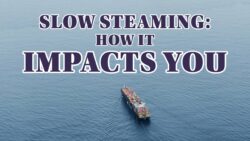
3-minute read
Newly-appointed New Zealand Council of Cargo Owners (NZCCO) chair Ant Boyles has expressed concern that container lines may opt for slow steaming to comply with pending International Maritime Organization (IMO) emissions-reducing regulations.
Energy Efficiency Existing Ship Index (EEXI) and carbon intensity indicator (CII) requirements are to come into force from January 1 next year, following amendments to the International Convention for the Prevention of Pollution from Ships (MARPOL) Annex VI.
An Update on the Global Supply Chain Situation 
4-minute read
The global shipping line Maersk reports that customers continue to face a raft of challenges as the Russia-Ukraine conflict weighs on the longer-term outlook for the global economy amid concern that inflation and higher energy prices will lead to lower consumer demand, damaging international trade.
According to Maersk, the short-term outlook, however, is more positive. Cargo volumes through Shanghai are returning to pre-lockdown levels, and demand from US consumers is pulling forward the peak shipping season on North American trades.
Increase in Containers Lost Overboard Sees Industry Take Action 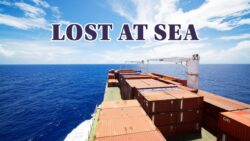
5-minute read
The latest loss of containers from the APL Vanda has once again thrown the spotlight on the problem of boxes being lost at sea and what can be done to prevent it.
The CMA CGM vessel suffered a stack collapse that saw 55 containers lost overboard from a single bay in heavy weather en route from Singapore to Suez, just before entry to the Gulf of Aden. No injury was reported.
NZ Biosecurity Measures to Protect Against Foot-and-Mouth Disease 
4-minute read
Since the foot-and-mouth disease was found in Indonesia recently, Biosecurity New Zealand have stepped up their work at the border to prevent the virus from arriving in New Zealand.
New Zealand does not currently have any flights directly from Bali or elsewhere in Indonesia to New Zealand.
Nevertheless, every passenger arrival card is examined, and those from countries that have Foot-and-Mouth Disease (FMD), including Indonesia, are directed to a different process of questioning, baggage search and disinfection.
Is Lack of Competition in Container Shipping Driving Poor Service and High Rates? 
5-minute read
New Zealand importers and exporters will not be surprised that the Global Shippers’ Forum (GSF) has released its finding that there is a lack of competition in container shipping – that reality has hit this country hard over the last two decades.
The only new brushstroke to this picture is that the GSF believes the true situation is largely hidden because of cooperation between carriers which results in a more highly-concentrated industry than appears on the surface.
Official summations of competitiveness fail to take this into account.
What’s Next for Container Shipping and Ocean Supply Chains? 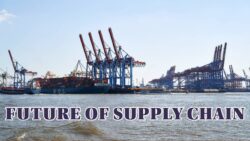
15-minute read
For those of us who lack the crystal ball, this extract from Lodestar’s interview with the CEO of Vespucci Maritime, Lars Jensen, one of the world’s leading analysts and former shipping executive, will hopefully provide some intel on the future of the supply chain.
Qingdao is the World’s First Hydrogen-Powered and 5G Intelligent Port 
2-minute read (30-second watch)
Shandong Provincial People’s Government has shared insights into its automated container terminal at Qingdao Port as part of the 2022 Qingdao Multinationals Summit.
Shandong Port Group and Qingdao New Qianwan Container Terminal explained that Qingdao Port is now one of the world’s leading automated container terminals equipped with state-of-the-art technologies, a high degree of automation and high loading and offloading efficiency.
What Does a Freight Forwarder Do? 
3-minute read
Shipping companies are increasingly ”going up and down the supply chain” seeking to take on some of the work that freight forwarders have traditionally carried out.
So, it is important to clarify what freight forwarders do and emphasise the value they bring to New Zealand?
New Rules for Importing Tobacco Products into New Zealand 
4-minute read
When you import or bring tobacco products into New Zealand, you must comply with New Zealand laws. You must pay all relevant taxes on your imported tobacco at the border.
What are the new rules for importing tobacco products?
From 25 May 2022, water-pipe tobacco is a prohibited import requiring a permit to import.
How to Import Dried Flowers Into New Zealand 
5-minute read
Dried flowers have become one of the most sought-after interior trends worldwide.
According to the Guardian, a summer of cancelled weddings during the global pandemic and havoc in global supply chains, presenting unprecedented challenges for floral businesses everywhere, have led to a big new trend of the dried flower craze.
But did you know that to import dried or preserved flower or plant products into New Zealand, you’ll need to comply with an import health standard for your product and meet various treatment, packing, and biosecurity requirements.
Auckland Port Abandons Automation Project and Welcomes World’s First E-Tug 
5-minute read (40-seconds watch)
Ports of Auckland’s new tug Sparky cruised into the port last week, notching a milestone as the world’s first full-sized ship-handling electric tug.
Ports of Auckland chief executive Roger Gray says welcoming Sparky is an exciting day for everyone.
“Sparky is the first e-tug of its type in the world and was a truly innovative project for us. Her arrival marks a big step towards the ports’ decarbonisation of operations and towards our long-term emissions reduction goals,” he says.
Supply Chains Issues Could Continue, Even as Shanghai Re-opens 
3-minute read (4-minute listen)
After two months of lockdown, Shanghai has ended many ‘unreasonable’ conditions, allowing businesses to resume work, starting from June 1.
The gradual reopening occurs just as the peak approaches for the Chinese export season to the retail markets of North America, Europe and the Australasian spring-summer retail season.
However, the supply chain could continue to be an issue, even as the world’s biggest port fully reopens.
The Chaos of Here and Now for Container Shipping 
On the carrier’s 175th anniversary, The Loadstar podcast editor and producer Mike King asks Hapag-Lloyd, the world’s fifth-largest container line, how the carrier is managing the chaos of the here and now?
What is being done to help shipper customers? Where will the windfalls of the last two years be spent? And what does the future hold for container shipping over the next 175 years?
Risks to Cargo Security Due to Longer Idle Times and Congestion 
5-minute read
Global cargo theft trends have shifted from the risk of in-transit, vehicle-based attacks to losses while cargo is at rest, with storage locations now critical at-risk areas.
Widespread congestion at ports and inland facilities led to increased opportunities for thieves during the period.
What You Must Know Before You Import Animals into NZ 
5-minute read
Did you know that if you are importing pets to New Zealand, they must be cleared through Customs when they arrive in the country? And you may have to pay GST and duties on some animals.
There are strict rules you must follow when bringing live animals into New Zealand. This page sets out the Customs requirements, please refer to the Ministry for Primary Industries (MPI) website for the Biosecurity requirements.
If you’re bringing an animal into NZ for commercial reasons, you’ll need to contact a Customs broker to undertake the process for you. Commercial reasons include breeding, showing and racing.
Are We Too Reliant on China? 
3-minute read
Many super-sized cities in China have been in tight lockdown for weeks as the country sticks to its zero-COVID strategy in the face of the fast-spread Omicron variant of coronavirus.
It is thought that some 340 million people, 25% of the national population, live in the 46 cities under full or partial lockdowns.
Port Omissions Hurt Importers and Exporters with Extra Costs 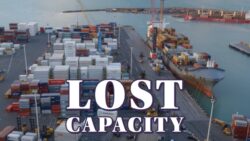
3-minute read
No week goes by – nor has gone by for about two years – without New Zealand importers and exporters receiving advice of port calls omitted by shipping lines.
Usually, there are one of two reasons. Either the ship is way behind schedule, and the operator is trying to recover something of the lag time, or there is congestion at a port or ports, and the operator can’t afford to have the ship sitting at anchor for a week or two.
In New Zealand, the delays at Auckland usually cause omissions, although the effects of congestion regularly spill over to other ports. Another regular occurrence is port diversions.
The number of ships that have diverted to Northport, and have found the Marsden Point operation satisfactory, has even encouraged Northport’s owners to move forward with plans to become a bigger container operation.
The downside of port diversions to shippers comes from extra costs to get their goods to and from the destination initially nominated as the gateway. The diversion port is almost always further away from where the goods are needed.
Research has now been done which shows that a global post-pandemic economic recovery is hindered by lines skipping ports or “blanking” sailings (i.e., cancelling them outright).
The MDS Transmodal (MDST) research, commissioned by the Global Shippers’ Forum (GSF), found that global ports lost over a third of their expected capacity to ship containers during 2021, creating delays and disruption for shippers.
“Lost capacity” measures the total number of container ship slots that were expected to be available at the port but did not materialise because the port was skipped or the entire service was blanked by the shipping line.
According to MDST, Tauranga lost about a third of its expected container capacity during the second half of 2021.
However, despite the supply chain delays and congestion, Tauranga benefitted from carriers diverting calls from Auckland, which lessened the impact it would have otherwise suffered from the supply chain crisis.
In 2017 the Port of Tauranga broke through the one million figure for containers handled (i.e., loaded or discharged). The throughput gradually rose to 1.23 million TEUs in 2019.
In 2020, the first year of COVID impacts, throughput rose to 1.25 million TEUs and then in 2021, it dropped only marginally to 1.2 million, according to Tauranga’s own published figures. A reduction of about 50,000 containers is not particularly significant, given the impact that supply chain delays and congestion have had on all ports.
However, looking beyond the Tauranga port, the big picture shows that the effect of missed calls has hammered many ports and shippers worldwide.
Some ports, such as Colombo (Sri Lanka) and Port Klang (Malaysia), have been especially hard hit, with about 40% of the expected container capacity failing to arrive in the last quarter of 2021.
Other ports such as Felixstowe (UK) and Jebel Ali (UAE) failed to see around a third of their expected capacity.
A skipped call means that a scheduled sailing won’t pick up cargo, and imports won’t be dropped off.
“As a result, the collapse in service levels available to shippers at the ports affected and in the hinterlands they serve over the period is stark and amounts to far more than the inconvenience of having to wait for the next ship,” the report says.
Skipped port calls also prompt rises in freight rates, as shipping lines ‘auction-off’ available slots on the vessels that do call.
Shippers also face unexpected surcharges for the handling and storage of delayed containers.
Nations lose the opportunity to deliver their exports, which hinders the recovery of their economies from the effects of lockdowns and COVID restrictions.
Such schedule alterations translate into huge capacities lost to importers and exporters.
As the pressures caused by the COVID-19 pandemic ease, hopefully, we will see the restoration of service predictability for shippers and a return to the frequency promised by consortia and alliance operators.
But it may not be for some time yet . . .
Source: The New Zealand Shipping Gazette
P.S. Easy Freight Ltd helps New Zealand importers & exporters to save money on international freight and reduce mistakes by guiding how to comply with Customs and biosecurity rules.
➔ Contact us now to learn how we can assist you.
Cargo Backlogs in China as the Covid Crisis Drags On 
6-minute read
As Shanghai enters the fourth week of its zero-tolerance Covid lockdown, forward export bookings are said to be down by 40% or more, prompting carriers to consolidate loads and blank more sailings.
According to one carrier contact, lines may be obliged to implement a “hardcore” blanking strategy to mitigate the impact of the cargo shortfall. The source said many of the numerous containerships currently at anchor off Shanghai port are “simply waiting for new orders”.
The concern is growing that the spread of COVID cases and city lockdowns in China will have massive downstream effects on global supply chains that could surpass previous disruptions since the pandemic.
Do Not Put All Your Freight Eggs in One Basket 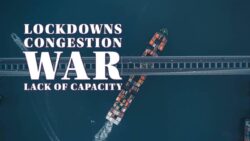
13-minute read (45-minute listen)
Lockdowns, ports congestion, war, lack of slots and flights – you name it, the supply chain has seen it all.
In this podcast of the Loadstar, a news resource for the global logistics industry, Mike King looks at the implications of more Covid-19 lockdowns in China, the latest on air and shipping capacity and prices, port congestion challenges, and what war in Europe is doing to air cargo markets.
China Import and Export Fair Goes Online 
3-minute read
China Import and Export Fair, aka Canton Fair, is one of the biggest trade events on the international trading calendar.
It is a platform for people who want to source products from China or current importers who want to see the latest China has to offer, find out about new trends for specific types of products, look for ideas for their businesses, and build long-term business relationships with Chinese suppliers.
It features products like Electronics & Household Electrical Appliances, Lighting Equipment, Vehicles & Spare Parts, Machinery, Hardware & Tools, etc.
The fair – held every year since 1957 – is the largest of its kind in China in terms of scale, variety, distribution of overseas buyers and business turnover.
However, this month’s event must go solely online, as China’s worst coronavirus outbreaks in two years have triggered lockdowns across the country, including in Shanghai’s financial and trade hub.
And parts of the country that have evaded lockdown are encouraging social distancing.
The fair’s operator said that exhibitors will now live-stream their products from April 15-24. Those hoping for an in-person event were left disappointed at the news that it will be online only this time.
Increasingly overwhelmed by supply-chain disruptions and soaring raw material costs, Chinese exporters are feeling the pinch from Covid-19 restrictions and Russia’s invasion of Ukraine.
Ding Qiangyu, a Guangdong-based exporter of car parts, was eager to meet other exporters face to face to help him assess the state of the industry and discern information that may not come out in a virtual forum.

“We actually really wanted to participate in the Canton Fair this month in hopes of reaching out to exporters in other industries, so at least we could get together and know a little more about their expectations and thoughts about the dramatic changes in trade,” Ding lamented after hearing the event will be online only.
Before the pandemic, the spring and autumn sessions of the Canton Fair in 2019 respectively attracted 195,454 and 186,015 buyers to Guangzhou. Foreign buyers from more than 200 countries and regions across the world also took part.
However, at the October 2021 event, the biggest concern among Chinese exhibitors was the rising cost of production amid global inflation and lack of foreign buyers, as coronavirus-related travel restrictions hampered attendance.
“We received no new orders at the Canton Fair this time [October 2021], which was within our expectation,” said Vicky Yang, a bag producer from Fujian province.
Kevin Huang, a furniture exporter, also said his business had received fewer orders since October.
“First-quarter orders this year were miserable, the second-quarter outlook is not optimistic … Inflation…and market concerns about the war, all will directly affect our orders because the furniture will become non-essential goods,” Huang said.
Exporters in China such as Ding Qiangyu are battling uncertainties resulting from soaring inflation, the Ukraine war, geopolitical disputes and China’s strict zero-Covid strategy.
Ding’s firm is now holding almost 10 million yuan (US$1.57 million) worth of goods in inventory. The warehouse space used and the rent are twice what they were last year, as he is trying to minimise the impact of rising raw material costs.
The survey by the American Chamber of Commerce on the impact of Covid-19 restrictions conducted from March 29-30 found that more than half, or 54 per cent, of foreign companies operating in China, had to cut 2022 revenue projections following the recent outbreaks, while 38 per cent said it was too early to gauge the impact.
A total of 167 member companies took part in the survey, including 76 manufacturers. Among the manufacturers, 86 per cent said their supply chains had been disrupted, and 82 per cent said they had slowed or reduced production.
How to attend the Canton Fair?
The 131st Canton Fair will be held online for 10 days from April 15th to 24th, and the Buyer Service Platform is available for buyers to register or log in: https://www.cantonfair.org.cn/en-US/register/index
Source: South China Morning Post
P.S. Easy Freight Ltd helps New Zealand importers & exporters to save money on international freight and reduce mistakes by guiding how to comply with Customs and biosecurity rules.
➔ Contact us now to learn how we can assist you.
Global Efforts to Prevent Anti-Competitive Conduct in the Supply Chain 
4-minute read
Competition authorities around the world – including our own here in New Zealand – are investigating the current state of container shipping markets and the rates being charged to exporters and importers.
Shippers and freight forwarders are irate about freight rates, restricted access to slots, and the expansion of shipping lines into other parts of the market. It has led to several calls for action.
Have a Peace of Mind – Invest in Cargo Insurance 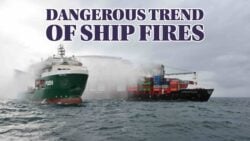
5-minute read
It takes something unusual for shipping to catch the attention of the mainstream public – such as the Ever Given blocking the Suez Canal – or the fire onboard the Felicity Ace and her subsequent sinking.
That interest wasn’t so much in the fact it was a ship fire – it was the fact that she was full of luxury cars. The thought of 4000 Volkswagen-Audi Group vehicles going to the bottom of the sea, with a value of something like NZ$550 million, became an international fascination.
Sustainable Aviation Fuel – Net Zero CO2 emissions by 2050 
4-minute read
The record-high prices of oil and commodities continue to bring challenges to a civil aviation sector worldwide that’s been hit hard by COVID. The industry has also been impacted by the tragedy unfolding in Ukraine in ways not seen for many years.
However, the industry still does its best not to forget about the environmental challenges as it pursues to progress towards the Flying Net Zero CO2 project.
So Many Containers – Yet Equipment Availability Remains a Problem 
3-minute read
There is no doubt container carriers are reaping record profits at the expense of cargo owners.
International maritime analysts Drewry recently stated that “ocean carriers have generated about US$190 billion of annual profits and about US$130 billion of fresh cash in 2021, obtained mainly by charging higher prices”.
Nonetheless, it is fair to say that there are also some additional areas of expenses they have to deal with, such as spiralling charter costs and high prices for second-hand container vessels (even older vessels that may otherwise have been heading for the scrapyard).
Exporters are Chartering Private Ships as Covid Cargo Crisis Continues 
10-minute read (23-minute listen)
Exporters are forced to charter private ships to ferry produce to foreign markets amid Covid driven cargo crisis. Meat producers and fresh fruit and vegetable producers are struggling to get goods to overseas buyers because of the ongoing containership congestion problem.
As more goods are being shipped and delays lay siege to best-by dates, meat company Affco has resorted to chartering private vessels to get exports – valued at close to $120m – to their overseas markets.
Detention and Demurrage Case May Set a Precedent 
4-minute read
There is nothing like detention and demurrage charges that affect the relationships between shipping lines, importers, customs agents and freight forwarders. Over the years, the disputes were taken to tribunals and courts.
Therefore, there’s likely to be significant interest in a fascinating case currently going through the deliberation process by the US Federal Maritime Commission (FMC), the US Government body that oversees competition in that country’s supply chain.
Longer Phase on Restoring Schedules 
4-minute read
Returning disruptive elements in the supply chain to anything resembling normality will take a lot longer than shippers, freight forwarders, ports, and governments will hope. One of the key disruptors, schedule reliability, is in the spotlight.
Even though supply chain problems continue to plague the industry, it appears that COVID is now entering an endemic phase rather than a pandemic, says Alan Murphy, CEO, Sea-Intelligence.
As such, it is also the time to take stock and contemplate how long it will take the supply chain to normalise, he says.
Strong Performance for Global Air Freight Markets 
3-minute read
Demand for air cargo increased by 6.9% in 2021, compared to 2019 (pre-COVID levels) and 18.7% compared to 2020, following a strong performance in December 2021, according to IATA data for global air freight markets.
This was the second biggest improvement in year-on-year demand since IATA started to monitor cargo performance in 1990 (behind the 2010s 20.6% gain), outpacing the 9.8% rise in global goods trade by 8.9 percentage points.
Vessel Delays and Rolled Schedules Result in Blank Sailings 
2-minute read
Carriers have traditionally used blank sailings as a tactical tool to manage supply to demand.
However, with the North American demand boom and the resulting port congestion, carriers have been struggling to meet their weekly vessel departure obligations, resulting in vessel delays, rolled schedules, and blank sailings.
How Companies Are Overhauling Supply Chains to Ease Bottlenecks 
1-minute read (5-minute watch)
The Covid pandemic has strained global supply chains, causing freight backlogs that have driven up costs.
Now, some companies are looking for longer-term solutions to prepare for future supply-chain crises, even if those strategies come at a high cost.
As a consumer, are you prepared to pay double for your products if you get them faster?
Freight Budgets Ramped Up Amid Record Profits for Shipping Firms 
2-minute read
According to a survey, almost all firms are raising freight procurement budgets, and some are doubling them amid spiralling shipping costs.
A report by Sleek Technologies said 97% of firms planned to increase freight procurement budgets in 2022 for reasons including better managing capacity, increased agility, bolstering cost management and delivering better overall results.
Prepare for the Key Issues of Supply Chain of 2022 
6-minute read
Should shippers prepare for a new round of disruptions in 2022? And what are the key factors to watch out for in 2022?
2021 was undoubtedly a year like no other for the supply chain as record vessel delays clogged ports and crammed warehouses. Smaller companies have had to fight to secure space on container ships to keep production and sales moving while facing cash flow pressure as they soaked up rocketing freight rates.
Unleashing the Potential of New Zealand Grown Cannabis Medicines 
2-minute read
Two of New Zealand’s largest medicinal cannabis companies have signed a supply contract that will pave the way for increased exports.
A five year multi-million-dollar deal between Marlborough-based cultivator Puro and Auckland-based Helius Therapeutics is New Zealand’s largest to date.
The Inside Story of Ever Given in the Suez Canal 
1-minute read (18-minute watch)
The six-day stranding of the Ever Given in the Suez Canal in March 2021 did something incredibly rare: it made regular people care about shipping, the means by which more than 80% of the world’s goods are transported.
It took only one wrong turn for the container ship to bring a critical trading artery to a standstill.
Importing Pet Food – Be Aware of Strict Requirements 
5-minute read
New Zealand has a strong import demand for pet food as the country has a large pet population. In fact, New Zealand has one of the highest rates of pet ownership in the world, according to Trade Data Monitor, with nearly half of all households owning a cat, and around one-third owning a dog.
Consumers also have high spending power, making it an attractive market for pet food.
Changes to Harmonised System (HS) effective 1 January 2022 
2-minute read
Every five years the World Customs Organization (WCO) revises the Harmonized System (HS) to improve it and accommodate advances in technology, environmental and social issues that are of global concern and require enhanced monitoring, and changes in the patterns of world trade.
Every Stop a Container Makes from China to Chicago 
1-minute read (9-minute watch)
The global pandemic triggered sky-high spending on manufactured goods. This increased spending created a huge bottleneck in the supply chain that could last for years.
In this video, you will follow one single container on its epic journey along the supply chain to find out where exactly things are breaking down.
Your Package Arrived Damaged, Now What? 
3-minute read (4-minute listen)
In an interview, Heather du Plessis-Allan talks to John Duffy, Consumer NZ CEO, about liability for damaged packages.
Does Your Parcel Meet New Zealand’s Biosecurity Requirements? 
2-minute read
NZ MPI Detector Dog Frisbee had an interesting find recently, sniffing out the unusual parcel contents at the International Mail Centre. The wrongly-labelled package was imported from China and contained three animal skulls with tissue still attached.
Extended Working Hours and More Truck Drivers to Help Solve Pressures of Supply Chain 
2-minute read
The issue of port congestion has been well covered in the media over the past year or so, but discussions generally tend to focus on difficulties in ports themselves or on decisions made by shipping companies.
Undoubtedly, there are significant problems there, but there are a lot of links in the supply chain, and sometimes it’s easy just to focus on the ones near the top that aren’t moving freely.
Steve Pugh, a member of Customs Broker and Freight Forwarders Federation of New Zealand, suggests looking a bit further down the supply chain.
Certainly, one area with potential to help smooth things out would be if more importers and exporters were to start taking deliveries of containers outside of normal business hours.
There seem to be several reasons that more companies don’t currently do this. Some receive a lot of containers and like to have staff on-site when they arrive to supervise container placement.
However, some issues could be addressed through good communication with trucking companies and providing out-of-hours and weekend access to sites.
It would also be good to see dehire depot operating for longer hours. With record volumes continuing to come through the ports, nothing can realistically be done about these often being at capacity. Still, extended opening hours for trucks to deliver and collect would go some way to help the overall situation.
Another issue is the shortage of truck drivers. Certainly in the South Island, many transport companies operate Monday to Friday. So if a vessel arrives on a Saturday, there is very little movement, which adds to the congestion in ports. Only the bigger trucking companies have sufficient staff to double shift a truck.
New Zealand has a major truck driver shortage – it’s particularly acute in Southland. The trucking industry is working hard to recruit more drivers, and the Government is supporting that through the Road to Success trainee programme.
A current example that may throw all these issues into sharp relief is that, at the time of writing, the Vaiga III vessel carrying around 2500 containers had just arrived at Northport, having been delayed in Singapore for some weeks.
No doubt this will be bringing very welcome cargo for the Christmas market. With containers expected to start moving out from December 12, there will be a lot of trucks on the roads to and from Whangarei that week, just as the Auckland cordon is lifted and holiday traffic is starting to kick off.
The Ministry of Transport is working with the industry to address congestion. Still, more practical solutions from importers and exporters, such as extended working hours and more truck drivers, are needed to help solve the pressures of supply chains going forward.
Source: The New Zealand Shipping Gazette
P.S. Easy Freight Ltd helps New Zealand importers & exporters to save money on international freight and reduce mistakes by guiding how to comply with Customs and biosecurity rules.
➔ Contact us now to learn how we can assist you.
Light at the End of the Tunnel for Supply Chain Chaos 
4-minute read (5-minute listen)
In an interview, Heather du Plessis-Allan talks to Sam Dickie from Fisher Funds about why the global shipping crisis might be wrapping up.
How To Grow Your Business? 
2-minute read
How can you grow your business quickly and sustainably? How can you tell which opportunities are worth pursuing? And what should you do if success takes longer than anticipated?
Here, NZTE private sector advisor Stefan Preston suggests the mindset you need to adopt, and the kind of business model you need to have to sustain rapid international growth.
Supply Chain Chaos To Continue Into Mid 2022 
1-minute read
Supply chain chaos will likely persist through to the middle of next year, Jim Snabe, chairman of German conglomerate Siemens and Danish shipping firm Maersk said in an interview with CNBC this week.
Is Schedule Reliability For Containerships Showing Any Improvement? 
2-minute read
Schedule reliability among the global container lines remains at the bottom of the range with only one-third of vessels operating on schedule.
The new data from research and advisory services company Sea-Intelligence shows only slight improvements in reliability and a small reduction in wait times confirming that progress will be slow in the recovery for the container shipping companies.
Did Covid-19 Affect Your Business? 
2-minute read
Trade impacts from COVID-19
New Zealand businesses have experienced major disruptions as a result of COVID-19, including those businesses in offshore markets. Disruptions experienced by NZ exporters have had flow-on effects to the domestic economy.
4 Lessons Learnt from Cargo Insurance Claims (Insider Tips!) 
5-minute read
Marine insurance claims have never been more topical, not just with shipments being compromised globally through congestion delays but with other one-off incidents hitting the headlines, such as thousands of containers that were stuck on the Ever Given in the Suez Canal and containers having literally gone up in smoke on the X-Press Pearl of Sri Lanka.
Record Air Cargo Demand Outperformed Pre-COVID Levels 
3-minute read
Supply chain disruptions have been among the key stories during the pandemic. Congestion and lack of capacity have led to large increases in shipping prices. But for importers & exporters, the different modes of transport are not always a perfect substitute.
NZ Road Freight Industry is Big Business (But Should it Be?) 
3-minute read
The road freight industry is big business in New Zealand, generating about $6 billion in turnover a year. About 260 million tonnes of freight is moved by road each year, accounting for about 93% of New Zealand’s total freight task.
2 Reasons Why New Zealand Has Problems In The Supply Chain 
3-minute read
The frustration and unpredictability of getting goods too and from New Zealand, has been discussed a lot over the past year.
Most supply chains globally were unprepared for these surges in consumer demand, but this is especially true for our country at the very end of that chain.
When and Why Ocean Freight Rates Will Go Down 
6-minute read
Not good news for importers & exporters. The “profit bonanza” being enjoyed by container shipping lines at present, through skyhigh freight rates, are set to remain in place for a couple of years more.
6 KiwiRail Benefits to NZ Economy ($2 billion in value) 
2-minute read
Rail in New Zealand has been estimated to provide a total value of $1.7 billion to $2.14 billion to the country’s economy each year.
What Are the Chances of Your Shipment Being Rescheduled? 
2-minute read
Global container shipping pressures remain acute with shippers and carriers impacted by ongoing delays, congestion costs, and capacity shortages.
Food & Drink Importers: Beware of Delays and Extra Costs 
3-minute read
Importing food, drinks and/or ingredients? Check that you are properly registered to avoid delays
To avoid unnecessary delays to their next consignments, importers of food for sale need to have a valid Food Importer registration and complete their Intended Use declarations for all consignments of food, drinks, and ingredients.
Sea Freight Price Predictions for 2021 (What & Why!) 
3-minute read
There are some large question-marks forming over the momentum of shipping freight rates and whether these will taper back when normality returns to international supply chains. Or have higher rates become the newest ‘new normal’?
What You Need to Know About Ports of Auckland Congestion 
6-minute read
The number of questions asked about congestion at the Ports of Auckland left me in no doubt that people are searching to understand the problems faced generally by the port, shipping lines and the transport industry.
Interview NZ Transport Minister (Solving Logistics Issues) 
4-minute read
Continued strong investment in rail, support for coastal shipping and development of road freight routes that service ports in particular are among the focuses of newly-appointed Minister of Transport Michael Wood.
5 Projects for NZ Transport Minister that Will Impact You 
5-minute read
Newly-appointed Transport Minister Michael Wood has got some big challenges to tackle during the next 3 years in power.
For the moment, he is still getting his feet under the table and being briefed on what he – and Infrastructure Minister Grant Robertson – face ahead of them.
What Should You Do During Sea Freight Peak Season 
4-minute read
There’s no way of sugar coating the pill regarding the current supply chain situation globally. It’s either severely stressed or broken, at almost every link in the chain.
Global Container Shortage a Threat to Importers & Exporters 
5-minute read
Consumers and businesses will be facing shortages over Christmas after major shipping lines halted new bookings from Asia on record global demand and the impacts of ongoing disruption at trans-Tasman ports.

1-minute read
Importers could face retrospective tariffs for bringing frozen fries to New Zealand. The Ministry of Business, Innovation and Employment (MBIE) has announced it is investigating the dumping of potato fries from Europe after calls from the local potato industry.
What Does The Latest NZ Freight Transport Index Tell You? 
2-minute read
Traffic volumes returned to more normal volatility over October as activity settled down after alert levels eased and catch-up activity was evident.
Perfect Storm for NZ Importers Desperate to Get Goods 
3-minute read
Bottlenecks related to logistics problems at Ports of Auckland, currently operating at an estimated third of its crane capacity, and an overloaded rail link from the inland Metroport hub to Tauranga, were seeing wholesalers and manufacturers now desperate for pre-Christmas goods and raw materials.
NZ Importers Face Huge Port Gridlocks & Container Shortages 
3-minute read
Shippers around the world face huge supply chain challenges from port congestion and an acute shortage of containers.
And one carrier source The Loadstar spoke to today said the problems “will get worse”.

4-minute read
Blockchain technology may be a way for NZ exporters to China overcoming the mountain of paperwork that slows deals, but it’s still some way from becoming commonplace.
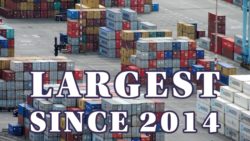
3-minute read
The global pandemic is boosting New Zealand’s trade balance and driving changes in the make-up of our exports and imports, latest StatsNZ data shows.

2-minute read
Freight passing through the Auckland port is suffering severe congestion in the lead-up to Christmas.
A Ports of Auckland union executive says the port’s move to an automated system is the root cause of its failure to cope with increasing volumes after weeks of industrial action in Sydney disrupted supply lines.
How the Chinese Golden Week Impacts You (October 1st – 8th) 
3-minute read
The Chinese National Day is celebrated from October 1st to 8th. Similarly to the Lunar New Year, almost all companies, including factories, are closed for business during one week.
This unparalleled event bears significant effects on sea & air freight services. Here you will learn everything you need to know about this unique time of the year.
NZ Ocean Freight Rates Go Up as Container Shipping Recovers 
3-minute read
Demand for container shipping services is starting to rebound as coronavirus lockdowns are eased, although the recovery is uneven and fresh outbreaks remain an ongoing risk.
What NZ Readers Are Saying About Ports of Auckland Location 
5-minute read
As mentioned in a recent article, my mailbag has been full with comments from readers about the future relocation of the Ports of Auckland, to such an extent that it is easily the most correspondence I’ve received on a single topic in years.

3-minute read
New Zealand’s Ministry of Primary Industry has provisionally finalised an updated import health standard for sea containers from all countries, as part of the prevention of the threat from importation of brown marmorated stink bug (BMSB).
5 Reasons Why Truckers Oppose Ports of AKL Move to Northport 
5-minute read
It’s not often you get an important transport lobby group arguing against something which could be of great financial benefit to them, but that’s the situation here with the group strongly advocating against a port move from Auckland to Northport.
What is the Real Value of NZ Coastal Shipping (vs Road) 
5-minute read
Will lightning strike twice with an EY (Ernst & Young) report into “externalities” producing a boost for a particular mode of freight transportation?
COVID-19: You Are Likely to Face Shortage of These Goods 
6-minute read
Delays in shipments and freight coming into New Zealand coupled with high demand for certain products has left stock and shelves empty for some retailers.
Air Freight Stats – NZ Imports & Exports (Aug 2020 Release) 
3-minute read
The cargo capacity crunch continues even as New Zealand businesses return to a post-lockdown normal, according to the latest air freight numbers from Auckland Airport.
Why Shipping Lines Rack Up Losses & Need Urgent Recovery 
5-minute read
As hopes for world trade gather momentum in the wake of countries loosening lockdown restrictions, the reality of the impact of COVID-19 on shipowners and operators is becoming apparent.
All industry segments have suffered from the pandemic with the possible exception of tankers, where there has been demand for floating storage.
NZ Import & Export Stats (July 2020 Release) – Trade Surplus 
4-minute read
New Zealand has recorded its fifth consecutive monthly trade surplus with the annual deficit falling to its lowest level in nearly six years.
Official figures from Stats NZ show a trade surplus of $426 million for June, taking the annual deficit down to $1.2 billion, the lowest since late 2014.
Seafarers to Stay on Ships for 17 Months Due to COVID-19 
6-minute read
When is a law not a law? When you work as a seafarer on a Panamanian Flagged vessel, apparently.
That appears to be the consequence of the decision by the world’s largest flag state to authorise seafarers on ships flying its flag to serve for as long as 17 months onboard, due to the difficulties of achieving crew changes during the coronavirus pandemic.
NZ Freight Sector Reality & Cargo Transport Outlook 2020 
4-minute read
The ‘new normal’ is a phrase we are now hearing a lot throughout the freight sector and the economy in general — but when will it arrive and what will it mean for your business?
Dangerous Goods: Calculating the Cost of Your Errors 
5-minute read
You may not be aware of all the risks of dangerous goods (DG) transport domestically. By “dangers” I am referring to miss declarations, errors in manifests or outright failure to declare DO.
Shipping Laws Changed – How it Affects New Zealand 
5-minute read
COVID-19 is having far-reaching effects on the shipping industry, and on importers and exporters, in ways that could never have been foreseen before the pandemic struck.
How Retailers Will Operate After COVID-19 (New Behaviours) 
6-minute read
The coronavirus (COVID-19) crisis is forcing stores to close across the globe. How should traditional retailers change in this new environment and with new consumer expectations and behavior?
Who Will Pay Penalties for Misdeclaring Cargo Weight (VGM) 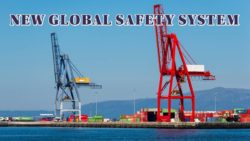
5-minute read
Four years after the introduction of VGM (verified gross mass) rules to deal with the dangerous problem of mis-declared containers, one could be forgiven for thinking the issue of overweight boxes had been eradicated.
Fascinating Facts about How Long-Haul Trucking Works 
1-minute read (13-minute watch)
Trucks transport 73% of the USA’s freight. However, in New Zealand they handle 92% of cargo, with 6% going by rail and 2% on coastal shipping.
Why Importers & Exporters Don’t Use Shipper Owned Containers 
2-minute read
The current market circumstances dictate New Zealand companies are not able to receive the full advantage of shipper-owned containers (SOCs).
Recently published by Hamburg-based Container xChange, the report determined that most freight-forwarders are failing to capitalise on the potential opportunities offered by SOCs.
World’s Largest Vertical Garden Goes up at Ports of Auckland 
2-minute read (3-minute watch)
Ports of Auckland has installed the world’s largest soil-based vertical garden on its new car-handling building on Auckland’s waterfront.
Dispute in Container Hire (Detention) fees – Is It Fair? 
4-minute read
The issues of container detention (empty hire) charges is an ongoing sore point which affects the relationship between shipping lines, importers, customs agents and freight forwarders, and it has raised its head again.
How COVID19 Affects Your Sea Freight Prices (Chart Supplied) 
5-minute read
The industry has navigated the crisis with some skill, but pressure to cut prices is growing.
For a container shipping industry whose fortunes depend on ever greater globalisation, the coronavirus pandemic appears an intimidating enemy.
Ocean Shipping Delays as Pandemic Hits Importers & Exporters 
4-minute read
The $1 trillion container shipping industry is in a slowdown. Literally.
Some shipping lines, whose retail customers are being hammered by the coronavirus pandemic, are reducing sailing speeds and taking longer routes around Africa, avoiding Suez canal passage fees, according to the companies and ship-tracking specialists.
Why Your Sea Freight is Getting Slower & Air Prices Going Up 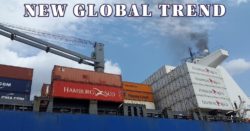
1-minute read (2-minute watch)
Shipping lines start sailing at reduced speed — a tactic that absorbs capacity since more vessels are required to provide the same frequency of service. How does it affect you?
Why You Are Not Getting Your Goods via NZ Post 
2-minute read
New Zealand Post has apologised for the delivery delays many Kiwis have experienced amid Covid-19, explaining why so many packages have taken so long to reach their new homes.
With courier drivers overloaded, orders that are usually delivered overnight are often taking at least two days, and in many cases sometimes even longer.
What’s Happening with the Auckland Airport Runway 
2-minute read
Work on Auckland Airport’s runway has begun as part of a $26 million project to replace pavement in the main touchdown zone.
Jet-blast fences were be transported onto the runway and 80 workers started work to shorten the airport’s runway by 1.1km in order to replace 280 concrete slabs at the eastern end.
Auckland Airport Stats Show How Covid-19 Changed NZ Imports 
3-minute read
Airfreight through Auckland Airport and around the world plunged in April but imports of some products to this country soared, including goggles, disinfectants and toilet cleaner.
As air travel started grinding to a near-halt, equipment to combat Covid-19 took up limited air cargo space, as footwear, clothing and makeup imports plunged.
Biosecurity for Air Transport (Near-Term Future of Aviation) 
9-minute read
Almost every challenge in aviation requires a team effort to solve it. Today we face the biggest challenge in commercial aviation’s history: restarting an industry that largely has ceased to operate across borders, while ensuring that it is not a meaningful vector for the spread of COVID-19.
New Rules for Importing Tobacco Products to NZ 
6-minute read
FREQUENTLY ASKED QUESTIONS
What are the new rules for importing tobacco products, tobacco leaf and refuse?
From 1 July 2020, tobacco products, tobacco leaf and refuse will become prohibited imports and you will be required to have a permit to import these products. Permits will be approved and issued by the New Zealand Customs Service.
Imports in April 2020 Had the Biggest Fall Since 2009 
3-minute read
Imports in April 2020 had their biggest fall since October 2009, resulting in a monthly trade surplus of $1.3 billion, Stats NZ said today.
“This is the largest monthly trade surplus on record and the annual goods trade deficit is the lowest since March 2015,” international statistics manager Darren Allan said.
Surge in NZ Exports of Food to China, Taiwan & Hong Kong 
4-minute read
New Zealand Trade and Enterprise says interest in fresh New Zealand produce is surging in China, Taiwan, and Hong Kong. The Chinese economy is beginning to recover after two months in lockdown due to the coronavirus – but the path to recovery is uneven.
Government Freezes NZ Customs Fees for Exporter & Importers 
3-minute read
The Government is freezing charges at the border to help export and import businesses and protect jobs from the impacts of COVID-19, said Minister of Customs Jenny Salesa.
A new fee regime for exporters and importers due to come in on 1 June has been put on hold for at least 12 months.
Outlook for Int. Air Transport & Freight in the Next 5 Years 
3-minute read
The International Air Transport Association (IATA) released a new analysis showing that the damage to air travel from COVID-19 extends into the medium-term, with long-haul / international travel being the most severely impacted.
How Airlines Transport Your Goods During Coronavirus COVID19 
8-minute read (12-minute watch (feel free to increase play speed 2X))
Why are airplanes grounded when the world needs it most? How will airlines fly again? it employs millions and acts as the central nervous system of international business and leisure.
YOU’LL LEARN:
- How Demand for International Travel Has Changed in the Pandemic
- Impact of COVID-19 on Air Cargo
- What Passenger Airlines Are Doing to Minimize the Supply-Demand Mismatch
- Why It Is Possible to Derive Profits from “Ghost” Flights
- What Happens Next
Government Freezes NZ Customs Fees for Exporter & Importers 
3-minute read
The Government is freezing charges at the border to help export and import businesses and protect jobs from the impacts of COVID-19, said Minister of Customs Jenny Salesa.
Impact of Social Distancing on Your Airfares As Borders Open 
4-minute read
With the outbreak of COVID-19, many governments implemented strict social distancing requirements to help limit the spread of the virus. Some governments have applied similar measures to air travel, including that airlines should leave empty seats between passengers in the aircraft.
When such policies are pursued, the seat load factor of an aircraft is artificially capped.
International Cargo Flights Ramp-Up to/from New Zealand 
7-minute read
Government support to help restore international air freight capacity has added 56 weekly cargo flights from New Zealand, with more to come, Transport Minister Phil Twyford announced today.
Short-Term and Long-Term Outlook on Logistics & Freighting 
2-minute read
Impact to date
Domestic transport and logistic services are in heavy demand replenishing stores with food and other consumer goods which have come into demand following preparations for the potential domestic impact of the coronavirus.
Survey of Airline Cargo Business Leaders (April 2020) 
7-minute read
Airline Business Confidence Index
KEY POINTS
• Our April 2020 survey of airline CFOs and Heads of Cargo confirmed the sharp weakening in the Q1 business environment amid the spread of COVID-19.
The challenging business backdrop – including weakness in profitability – is expected to be maintained through the next twelve months.
• Passenger and cargo demand both collapsed in Q1, although the decline was more pronounced for passenger traffic.
Yield developments were mixed, with respondents reporting that passenger yields eased over the course of the quarter, while cargo yields increased.
Air Cargo Supply & Demand Analysis (Released April 2020) 
7-minute read
Air Cargo Plunges in March as Covid-19 Spreads Globally
• Industry-wide cargo tonne kilometres (CTKs) contracted by 15.2% year-on-year in March, driven by sharply weaker demand across all regions as the COVID-19 outbreak extended to become a global pandemic.
• Industry-wide cargo capacity declined by 22.7% annually due to the reduction in bellyhold capacity, as the passenger fleet were increasingly grounded. Dedicated freighter operations raised their capacity and some passenger aircraft shifted to cargo-only operations which partly offset this decline. With capacity contracting by more than demand, the global cargo load factor improved by 4.8 ppts in March, compared with the same period a year ago.
NZ is Facing Shortage of 20ft & 40ft Shipping Containers3-minute read
There is a growing shortage of shipping containers. Cargo and freight being exported use the empty containers from goods that come into the country.
With a drop in imports containers may become scarce. Will you be affected?
Guide to New Import GST Rules for Online Shopping 
4-minute read
YOU WILL LEARN:
- New GST Rules On Low Value Imported Goods
- Tips On Online Shopping for Christmas
Reporter: There is going to be a significant change for online shoppers in New Zealand, just in time for Christmas.
NZ-bound Shipment Has been Intercepted (Could it Affect you?) 
1-minute read
New Zealand Customs Service has issued a reminder to NZ importers to ensure they correctly declare the origin of inbound goods on import entries — particularly from Western Sahara.
“In the case of imported goods originating from Western Sahara, the country code ‘EH’ should be input in the import entry’s origin field,” stated the agency.
NZ Freight Company Lost Insurance Claim Due to the Employee’s Fault 
6-minute read
You may have good insurance, pay the premiums on time but then have the insurance claim denied because your employees were not trained to meet the requirements.
Let’s discuss how your business needs to operate to ensure that you are covered when disaster strikes.
What Are the Funding Options to Grow Your Import or Export Business 
1-minute read (22-minute watch)
Access to a wide investor audience, so it’s a quick and efficient way for you to raise funds.
This week our guest speaker was Simeon Burnett is the CEO & Co-Founder – Snowball Effect. It is New Zealand’s leading online investment marketplace. They help NZ companies raise funds to increase the rate of your company’s growth.
3 Tips On Importing Goods Into New Zealand (Avoid These Hidden Costs) 
13-minute read (27-minute watch)
If I had this info before I imported for the first time I’d saved lots of time & money
📚 YOU WILL LEARN:
- How NZ Customs or NZ MPI Biosecurity will charge you and some hidden costs that you may not be aware of
- What are the common mistakes in the transport documents
- How you can save money on freight
- Other Practical Advice that Will Help You Grow
NZ Importers Fed Up With Container Hire / Detention Fees (Go to Court?) 
5-minute read
Last week’s Commentary column explored the supply chain friction that is occurring with container detention charges one of the central issues.
In recent times, where container depots around Auckland have been full, and the truckers working for importers and forwarders have been unable to de-hire empties, arguments have erupted when detention notices have been issued.
5 Little-Known Mistakes with NZ Customs Clearance (Instant $800 Fines) 
11-minute read (22-minute watch)
Import rules change on a regular basis. Find out what can cause extra delays or fees.
📚YOU WILL LEARN:
- Ways that an overseas supplier can ruin your compliance with NZ authorities.
- Situations when you are paying too much or too soon.
- How NZ Customs or NZ MPI Biosecurity will charge you and some hidden costs that you may not be aware of.
Alibaba Auckland Expo: How NZ Businesses Should Trade with China 2-minute read
One of the biggest E-commerce firms Alibaba has announced plans to establish a local office.
Alibaba Group Australia and New Zealand regional general manager Maggie Zhou confirmed that the business expects to achieve a stronger local presence.
Why Auckland Has Container Shortage (What Is Done Overseas to Fix It) 
3-minute read
Around 90% of the dry goods 20-foot containers (TEU) imported into New Zealand come in full with imported product.
However, around 30% of 20-foot containers (TEU) leaving New Zealand do so empty.
The shipper or shipping line that works out to close the imbalance gap would not only be making a significant contribution toward the nation’s trade surplus but to the national supply chain. The 30% of empty boxes pose a growing issue.
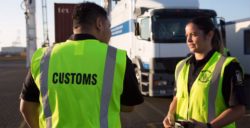
Wednesday, 29 May 2019 at 1 pm (NZ Time)
This is a FREE educational business webinar to help NZ importers & exporters.
YOU WILL LEARN:
- Little-Known Ways to Reduce Your Costs
- What to Say to Get a $200 Instant Price Drop
- How to Avoid Hidden Fees and Nasty Surprises When Send Your Goods
- Q + A: Type Your Questions Now (or During the Live Talk) to Feel Confident With Importing/Exporting Your Cargo
Issues With Abandoned Shipping Containers – You May Be Liable! 
3-minute read
Freight importers & exporters should be worried about the cost of containers abandoned overseas for which they may be liable and how to implement safeguards to prevent this situation occurring.
How to Get The Best Cargo Insurance (4 Myths Busted) 
11-minute read (20-minute watch)
As an NZ importer or exporter, you’re no doubt always on the lookout for ways to save money. But there’s one place you shouldn’t be skimping on, and that’s cargo insurance.
This is an educational business webinar to help NZ entrepreneurs understand how to get the best out of the cargo insurance and what to avoid.
Why Sustainable Business is Better (3 Tips to Make a Difference) 
13-minute read (19-minute watch)
How do you deal with competitors that copy you? Ways to stay relevant to the market.
This week our guest speaker was Shay Lawrence is the founder of CaliWoods, loves surfing and the ocean.
Passion lies in using business as a force for good, developing her own business in the Social Enterprise space and inspiring people to live more sustainable lifestyles.
Business Planning & Top 3 Tips to Increase the Value of Your Company 
1-minute read (27-minute watch)
Growing your business alone is challenging. If you apply the right system life will be easier.
This week our guest speaker was Graeme Hogan is a CEO with 20+ years of experience in both small & large companies, covering most aspects of the business – from sales, marketing, as well as business planning.
What You Must Do to Get New Clients (Grow Your Business 3X) 
1-minute read (27-minute watch)
Steps to increase your sales by 3 times and grow your business.
This week our guest speaker was Logan Wedgwood is a sought-after management consultant specialising in business sales and marketing.
How to Get to the Top of Google Search & Increase Your Sales Leads 
1-minute read (23-minute watch)
You can do these simple website changes and beat your competition. No huge budget required!
This week our guest speaker was Richard Conway is the CEO and founder of Pure SEO Ltd.
How to Navigate New Taxes and Minimise Issues with Business Compliance 
1-minute read (17-minute watch)
1) How to navigate the new taxes – check which apply to you. 2) Round-up of 2019 law changes.
This week our guest speaker was Kirk Hope is Chief Executive of BusinessNZ.
How to Get New Clients via Social Media Marketing (3rd Rule is Vital!) 
1-minute read (22-minute watch)
Do you want to stand out among your competitors? How to do it using just your smartphone?
This week our guest speaker was Jef Kay from Easy Social Media Ltd.
Instant Fines by NZ Customs (70 Offences That Can Incur It) 
6-minute read
NZ Customs officers can issue Infringement Notices, with an instant fine of $400 for an individual or $800 for a business.
Infringement Notices enable Customs to manage minor offending involving travel, goods and craft (aircraft or ship) by issuing fines for 70 offences.
Ports of Auckland Profit is Down $5 mil and 50% of Ships Arrived Late 
12-minute read
Ports of Auckland CEO, Tony Gibson has announced the company’s half-year results:
Our company is in the middle of a major investment programme which will increase capacity, efficiency and returns. This work will give us a solid foundation for a sustainable future, but while construction is underway there is a tangible effect on our business.
More Vehicle Import Troubles with Ineffective NZ Biosecurity Rules 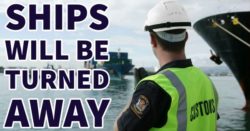
3-minute read (4-minute listen)
Newscaster: The car shipping line, Scandinavia’s Wallenius Wilhelmsen, is telling the government that the biosecurity rules that are meant to keep the marmorated stink bug pest out of New Zealand are ineffective and inconsistent.
New Container Inspections by the Shipping Line May Add Extra Costs 
2-minute read
Maersk and other carriers in the industry are working to improve safety and reliability in the Containerized Maritime Supply Chain, by verifying that cargo descriptions match actual contents of the container, and that the contents of the container are correctly stuffed, lashed and secured.
Proven Online Marketing Tactic for 2019 & Top Mistakes Businesses Make 
25-minute read (43-minute watch)
You Will Learn:
- What marketing tactics you must use in 2019 and what to ignore.
- How to avoid common mistakes.
- And other practical tips you can implement today!
Why New Zealand Import Businesses Fail and Tips on How You Can Avoid It 
15-minute read (25-minute watch)
You Will Learn:
- Why do most organisations collapse?
- How did the leaders of the popular companies make decisions that triggered the breakdown of their business?
- And other practical tips you can implement today!
4 Outcomes for NZ Importers & Exporters During the Next 25 Years 
5-minute read
We looked at a document called “Brave new world? – Container transport in 2043” published by leading international freight transport insurer TT Club, in conjunction with global management consulting firm McKinsey.
Winner of the 2018 Day of the Seafarer Photo Contest (1700 Entries!) 
2-minute read
Myanmar-based Master Zay Yar Un has won the inaugural International Maritime Organization (IMO) Day of the Seafarer Photo Competition with what has been described as a “bold geometric composition, focusing on the deck of a ship and the blue ocean beneath”.
Reasons for the Import & Export Freight Hold Ups in Auckland 
6-minute read
The fragility of New Zealand’s supply chain has been exposed several times in recent years, for example through the Canterbury and Kaikoura earthquakes which hammered the ports of Lyttelton and CentrePort, and the 2012 Auckland industrial troubles which disrupted operations there and put huge pressure on the Port of Tauranga as a back up.
3 Recommendations Where to Move the Ports of Auckland 
5-minute read
There is one thing that the freight industry needs to see come from the Upper North Island Supply Chain Strategy review which the Government is finally getting underway – a result.
By that, I mean clear recommendations that oblige the Government to take action, in order to give us a way forward for the manner in which the ports, rail and roads in the upper North Island will develop over the next 30 years.
Cleaning Cert. & Other Things MPI Checks to Allow a Vehicle Import 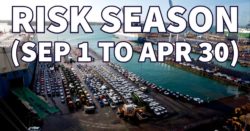
2-minute read
Importers will have to do more to ensure vehicles and machinery from overseas are free of brown marmorated stink bug (BMSB), according to the Ministry of Primary Industries.
The new Import Health Standard for Vehicles, Machinery and equipment that came into force on September 1 have a focus on Japan given the issues last season with contaminated car carriers.
What It’s Like to Air Transport a Live Rhino Across the World 
3-minute read
An eight-year-old black rhino is settling into a new home in the Serengeti thanks to a complex logistics project managed by Intradco Global and Qatar Airways Cargo.
After spending his entire life at the San Diego Zoo Safari Park, Eric was selected to move to Tanzania to play a starring role in a breeding programme designed to help save the critically endangered species from extinction.
Why a Lot of Auckland Companies Will Have to Work 24/7 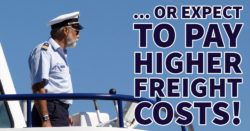
3-minute read
National Road Carriers Association and the Ports of Auckland are combining forces to promote change in the supply chain to improve delivery times and prevent delays.
This initiative has come about because of supply chain capacity issues which were highlighted following an accident at Ports of Auckland in August. Imported freight has taken longer to deliver, and exporters have encountered delays getting their goods away, leading to frustration all around.
E-scooter: NZ Import Safety Concerns and How it Affects You 2-minute read
Peter McRae is calling on authorities to promptly address “regulation, categorisation and commercial concerns” regarding the importation of E-scooters.
In a publicly-released commentary, Mr McRae identified issues in three specific areas:
- Appropriate design and resulting classification of E-scooters as vehicles for transportation, not toys.
- Risk management for the expected increase in future motorised scooter imports.
- Need for greater regulation and systemic collaboration to ensure rider safety (via helmets, speed, etc.) as well as ensure public safety.
Risks of Importing Vehicles or Machinery from China & Korea 
4-minute read
Advice to shippers, exporters and importers of new and used vehicles and machinery from China and Korea.
At this stage, New Zealand does not have specific Brown Marmorated Stink Bug (BMSB) measures in place for vehicles and machinery from China and Korea. However, MPI is currently monitoring vessels reporting detections of BMSB and other regulated pests that are carrying vehicles and machinery from China and Korea.
Vehicle & Machinery Importers Are Warned of Extra Fees 
2-minute read
Importers of vehicles and machinery from Japan and “Schedule 3″ countries are being advised they will need to have acquired an approved Biosecurity Authority Clearance Certificate (BACC) at least 72 hours prior to vessel arrival in New Zealand.
Import Delays to NZ Are Getting Worse (Is There a Solution?) 
5-minute read
The Customs Brokers and Freight Forwarders Federation (‘CBAFF’) told Shipping Gazette™ it is actively working towards resolution of issues with MPI clearance delays.
Chris Edwards, vice president of CBAFF, said the Trade Single Window (TSW) issues are top of mind for the industry and no solution is yet in sight.
How to Import Hemp (Cannabis) Seed as Food into New Zealand 
9-minute read
From 12 November 2018 hemp (cannabis sativa) seed food products will be able to be imported into (and exported from) New Zealand. What are the rules?
Importers and exporters should note products must NOT contain whole hemp seeds. Whole hemp seeds remain Class C drugs under the Misuse of Drugs Act 1975 and cannot be imported into New Zealand without a licence issued by the Ministry of Health.
New Import GST on Goods Valued Under $1000: the What & How 
25-minute read
The government is cutting import taxes on low-value goods to soften the impact for New Zealand consumers who start paying GST on all overseas purchases next year.
Following consultation earlier in 2018, details were released on 18 October 2018 on the proposed GST regime for non-residents supplying “low-value goods” to NZ buyers.
NZ Customs Departure Card Cancelled: What You Need to Know 
2-minute read
Departure cards have been discontinued this month, and the information used to account for all travellers departing New Zealand will now be collected electronically.
You still have to meet some requirements to avoid problems.
NZ Importer Jailed for Smuggling Goods (What Can You Learn?) 
4-minute read
Let’s discuss the volume of alcohol being illegally imported into the country and imported without compliant labelling. What are the telltale signs of illegitimate product?
Citing examples of imported shipping containers being declared as beer when they were predominantly filled with spirits. That kind of smuggling is denying the country of about $40 million in excise duty annually.
NZ Customs and Spirits NZ are working on ways to stop it. How will you be affected?
Cargo Insurance Costs & 3 Little-Known Issues You Must Avoid 
6-minute read (10-minute watch)
You Will Learn:
- How to save money on cargo insurance
- The costs to insure your goods in New Zealand
- Three common mistakes that you need to avoid
- And other practical tips you can implement today!
Updated NZ Customs Rules & Fees: What You Need to Know 
12-minute read
Administrative Penalties
Administrative penalties apply to exporters, importers, licensees and agents who make an error or omission on their entry and do not voluntarily disclose it to Customs.
New Sea Freight Fuel Prices – How it Will Affect You (Q&A) 
4-minute read
From 1st January 2020, a new regulation will come into force to reduce air pollution from ships globally. Whereas today ships can use fuel with up to 3.5% sulphur content (outside Emission Control Areas), the new global sulphur cap will be 0.5%.
How Ports of Auckland Automation Will Affect Importers 
5-minute read
Progress is being made on the massive automation project being undertaken at the Ports of Auckland , as the port readies itself to become the first in New Zealand to use automated straddle carriers to load and unload trucks and to operate the container yard.
Why are Freight Fuel Prices (BAF) Going Up & are They Valid? 
5-minute read
Recent Shipping Gazette™ news articles and the Commentary column focusing on emergency bunker surcharges being applied to shippers (June 9) have prompted interest from readers who have asked the basic question – how are BAF (bunker adjustment factors) calculated?
How to Hire Top Talent & Tips to Improve Team Happiness 
4-minute read (7-minute watch)
You’ll learn:
- How to hire the best talents for your business
- Important steps and techniques of the hiring process
- Why you need to have team discussions
- Ways to improve the communication in your team
- How social networks can help your business
Costs to Import One Pallet (or More) from Australia to NZ 
5-minute read (9-minute watch)
You’ll learn:
- What are the costs to import 1 pallet of standard goods from Australia to NZ
- The main components of these costs
- In what way you can calculate the cost of importing more than 1 pallet
- How your customs broker can help you save money
- Why a local freight forwarding company is better
Prices to Import One Pallet (or More) from China to NZ 
5-minute read (9-minute watch)
You’ll learn:
- What are the costs of import from China to New Zealand
Which freight incoterms to choose and why
All fees included in the NZ port fees
Extra fees that you should account for
- How to calculate the cost of importing 1+ pallet from China to NZ
How to Decide if You Need Cargo Insurance & Who Pays for It? 
6-minute read
One of the examples of how “General Average” works was Maersk’s declaration of it following the fire on board the Honam. It caused some interesting feedback relating to the value of having marine cargo insurance.
In particular, the issue that was drawn into sharp focus was the risk borne by all New Zealand exporters and importers, who proceed to ship goods without marine insurance.
Amazon Tax: What You Need to Know & Beware of This Trap 
17-minute read (11-minute watch)
You’ll learn:
- Who benefits from this new tax
- Current GST rules, how and when they are going to change
- How much you have to spend on customs clearance, including customs broker fee
- What you should be aware of in regards to Amazon Tax
Top 5 Recruiting Mistakes by NZ Import & Export Businesses 
27-minute read (46-minute watch)
You’ll learn:
- Is it worth to have a recruiting agency and how much do they charge
- What is the difference between “passive” and “active” candidates and how you can use that
- How you can grab the attention of applicants in your ad
- Why it is so important to gather critical information about a candidate upfront
- Is it good or bad to advertise the exact salary
- Why it is a good idea to have somebody to assist you in the interviews with candidates
- How to improve your interview skills and have “structured interviews” with candidates
- Is there a pay gap between males and females in New Zealand
True Costs to Import 20ft Container to NZ (How to Save Money) 
20-minute read (42-minute watch)
Max: If you want to learn more different business tactics, tools and how to import or export goods to New Zealand then start now by subscribing to our YouTube channel .
Alex: You want to bring a 20-foot container from any country to New Zealand, where do you start?
5 Expensive Mistakes When You Import Used Household Effects to NZ 
7-minute read (19-minute watch)
Max: All these five mistakes apply whether you import a full container , air freight, or even 100 kilos by sea freight, and it’s very important to make sure that you prepare all these things before you arrive in New Zealand.
Make sure you do not arrive before your shipment arrives in New Zealand.
3 Reasons Why I Want to Ditch My Business Partner! (Number 2 is Vital) 
8-minute read (18-minute watch)
Max: We wanted to sit together and talk to you about a very sensitive subject for many. Alex and I are both co-founders and directors of the beautiful company called Easy Freight. And we’ve been in business for a long seven years!
Importing Goods to NZ? 4 Ways an Overseas Supplier Will Cost You 
11-minute read (28-minute watch)
Max: Were talking about importing goods to New Zealand, and four ways the supplier will cost you extra money that you didn’t budget for.
#1 YOU RECEIVE LESS THAN EXPECTED
The first way that you can lose money is, surprisingly, some New Zealand importers can receive half-full containers.
How to Select an Auckland Customs Broker – Avoid THESE Costs 
11-minute read (23-minute watch)
Max: If you think about it, when you import two pallets or even a full container, you’re going to pay at least anywhere between NZD 1,000 to 5,000 of freight to ship the goods say from China to New Zealand .
Alex: So why we think that it’s so important not just to choose right freight forwarder but also to choose the right customs broker?
How to Save $3,105 on Importing Your Used Personal Effects to NZ 
12-minute read (26-minute watch)
Max: We’re going to talk about mainly importing containers with used household goods to New Zealand.
And it’s going to be a very topical question, how to save money when you migrate and bring your stuff to New Zealand . What’s the first step when you prepare to bring your goods to New Zealand?
Price Breakdown: Import One Pallet of Goods from China to NZ 
7-minute read (14-minute watch)
Today we’re going to talk about the price breakdown if you want to import one cubic metre standard pallet of goods from China to New Zealand.
This is the most commonly asked question, so I’m delighted to finally break it down for you.
3 Things I Know About My Business Partner, But His Wife Doesn’t 
8-minute read (16-minute watch)
Max: Today we’re talking about “Three things I know about my business partner, but his wife doesn’t.” And I think I should clarify some very important things straightaway. I’m not married. Alex is not married either. So we don’t live double lives. Do you Alex?
How & When Autonomous Ships Will Change Imports & Exports 
3-minute read (3-minute listen)
Newscaster: Well, self-driving cars, and driverless trucks, also airliners that fly on autopilot. They’ll soon be commonplace. What about crewless container ships though? Well, they’re just over the horizon, as it were. Eric Frykberg plots their course.
Eric Frykberg: Coming soon to a port near you, the crewless ship with a skipperless bridge nosing itself towards a wharf to unload its cargo. One or two people might be needed to keep an eye on the computers, but they won’t necessarily be on the vessel.
Online vs Physical Retail: What’s the state of NZ shopping? 
6-minute read (8-minute listen)
Mark: Greg Harford is from Retail New Zealand . He joins us now. Hey, are you all doomed to put up the shutters and close up?
Greg Harford: Well, we represent the retail sector including some online retailers.
Peter from Stoeveken Cosmetics shares tips for NZ Importers 
1-minute read (20-minute watch)
Today my guest is Dr. Peter Stoeveken co-founder of Stoeveken Cosmetics Ltd who will share his tips for NZ Importers & Entrepreneurs.
They are NZ importers of 100% natural and certified organic beauty care products from Germany.

6-minute read (9-minute listen)
The boom in global trade was caused by a simple steel box. Shipping goods around the world was – for many centuries – expensive, risky and time-consuming.
But, as Tim Harford explains, 60 years ago the trucking entrepreneur Malcolm McLean changed all that by selling the idea of container shipping to the US military.
What are the Problems of Moving Auckland Port to Northland 
3-minute read (6-minute listen)
Guyon Espiner: New Zealand First is suggesting to move the Ports of Auckland to Northland. This has been met with some scepticism, particularly from the National Party. We had Simon Bridges on the program a little earlier.
A Cheaper, More Foolproof Way to Import Goods — To Anywhere 
8-minute read
1. Can you deliver?
Part of securing export orders is making sure you can deliver. Many Kiwi exporters have underestimated the volume opportunity they encounter overseas. Similar issues arise for NZ importers.
What You Need to Know About Import & Export Compliance 
14-minute read
Understanding Regulations
Trading rules and regulations vary from country to country and import legislation can be both complicated and confusing.
6 Things to Do Before the Import of Your Goods (#5 is a Must) 
6-minute read
MINIMISING THE FINANCIAL RISK
Finance is obviously fundamental when exporting & importing: you want to be paid quickly and without complications . Here are some factors to cover.
The Ultimate Guide: Food Import Customs & MPI Clearance 
4-minute read
What is this about?
To import food into New Zealand (NZ) you need to apply and get clearance from both NZ Customs and the MPI (Ministry for Primary Industries).
How NZ Corporates can Damage Your Small NZ Import Business 
4-minute read
Reporter: Lisa Wilson is on the line with me now. Good day, Lisa.
Lisa Wilson: How are you doing?
NZ Customs Can Inspect Your Digital Devices at any Airport 
6-minute read
Reporter: The new Customs and Excise Bill means Customs will no longer be able to demand that people entering the country hand over the passwords to their devices without reasonable cause. Although, is that a change?
New Tax on Imported Goods to Australia: What NZ Companies Need to Know 
3-minute read
Note that the legislation will not affect customs duty, which is still not payable below the AU$1,000 threshold.
Your Cargo Can be Stolen Using 3D Printing Technology 
2-minute read
For some time we have been looking to identify the potential long-term impact of 3D printing on the movement of goods in the supply chain but now manufacturers and transport providers are being warned of how the criminal fraternity are using the technology to help steal goods from containers.
How to Cut Your NZ Freight Costs and Improve Service 
3-minute read
An online shipper/truck operator matching service recently launched by New Zealand startup, TNX , is reportedly delivering 10% cost savings to the former while also reducing the 40% under-utilisation of vehicles said to currently be commonplace for the latter.
Who Should Pay for These Extra Costs and How to Avoid Them 
4-minute read
In mid – July a freight forwarder filed a container pre-receival advice to DP World Australia at Melbourne port, and while doing so made a typo error with the weight, missing out a “zero” numeral …
The Main Reason Your Shipment Could be Delayed 
3-minute read
A number of CBAFF members have raised concerns recently about delays with New Zealand Customs releasing shipments.
Naming and Shaming the Worst Unjustified Freight Surcharges 
2-minute read
Global Shippers’ Forum (GSF) secretary general Chris Welsh has announced his organisation aims to stamp out shipping surcharges within five years.
The Ultimate Guide: How to Make & Source Your Goods Overseas 
27-minute read
(This is the interview with Richie Norton by Pat Flynn from Smart Passive Income).
This month, I’m learning everything I can about the world of physical products: how to create my own, how to validate them, how to find the perfect manufacturer, and how to get them in the hands of my customers.
What You Must Know Before You Import Food into NZ 
5-minute read
What is this about?
To import food into New Zealand (NZ) for sale individuals need to understand and comply with requirements under the Food Act 2014. This guidance will help you with this.
Good News for Importers & Exporters – New Freight Tech 
5-minute read
The container shipping industry had one of its worst years in 2016. In his Editor’s Insight, Nevil Gibson says a recovery is underway and that’s good news for importers and exporters. Nevil Gibson joins me now. How bad was 2016 for container shippers?
Counterfeit Shipping Containers: What You Need to Know to Prevent It 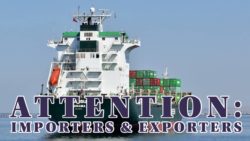
2-minute read
A counterfeit containers warning issued to the Customs Brokers’ and Forwarders’ Council of Australia (CBFCA) by Australia’s Department of Immigration and Border Protection (DIBP) , could serve as a timely portent for New Zealand shippers.
Customs Brokers Call for an Urgent Solution to Freight Problems 
3-minute read
Mainfreight says KiwiRail needs to find an alternative way to get urgent freight from Auckland to Christchurch as fast as it can. Earthquake damage has left CentrePort in Wellington unable to load and unload container ships and has damaged the rail link to Christchurch, forcing trucks to take up the slack.
NZ Imports and Exports are Delayed After the Earthquake 
3-minute read
Importers and exporters are piling work onto other New Zealand ports as they scramble to keep cargo moving after last month’s earthquake blocked most of the trade out of Wellington .
Soon You Will Pay Import Taxes On All Small Parcels 
3-minute read
You might soon have to pay GST on all the goods you buy online, not just purchases of digital goods including music, software and films and TV shows.
Will Your Import & Export Freight Rates Go Up Or Down? 
3-minute read
Hanjin’s receivership represents the greed of the container shipping market, and despite continuing concerns of weak trade growth and fleet oversupply, a gradual market recovery is now expected, according to the latest annual Container Forecaster and Review 2016/17 report published by global shipping consultancy Drewry.
Little-Known but Vital Online Import Tax Rules 
5-minute read
The online shopper is questioning what happens to the GST and customs duty, charged on purchases from overseas when goods are returned.
Back To The Port Of Auckland Future 
6-minute read
When I looked in March at the work that had been released by the Port Future Study’s Consensus Working Group (CWG) , identifying a long list of areas being considered as options to meet Auckland’s future demand for a port, I had major reservations about some of the options being considered – particularly Muriwai, the Kaipara Harbour, Mahurangi (south east of Walkworth), and Whakatane.
What Happens When a Shipping Line Goes Bankrupt? 
2-minute read
In a week when one of the world’s top ten container lines went bankrupt, the business performance of shipping and ports has come firmly under the spotlight, not just globally but in NZ too.
Your Freight Agent May Be Charging Inflated Fees 
2-minute read
Reports are emerging of some carriers and other supply chain service providers imposing “exorbitant and unjustified charges” in particularly Asia and Africa following the July 1 enactment of the new verified gross mass (VGM ) regulations for packed containers.
Why You Need Export Trade Insurance from NZ Government 
2-minute read
New Zealand exporters seeking financial protection against the non-payment by a customer could find themselves eligible for trade insurance from the New Zealand Export Credit Office (NZECO).
9 Facts You Need to Know About Mandatory Cargo Weighing Law 
4-minute read
As advised earlier and as constantly reported in industry press the new Mandatory Cargo Weighing Laws has become effective around the globe.
This law is referred to as V.G.M. or Verified Gross Mass, when a ship will not load a container anywhere in the world without a declared VGM.
Dispute Over Import Freight Charges (And What to Do With It) 
2-minute read
The freight forwarding charges debate here in New Zealand, as discussed in the past , has probably come to a head with the statement by the Commerce Commission that “it is not the commission’s role to enforce “Incoterms ” in contracts between forwarders and importers.”
Importers: Alert to New and Used Parts from USA 
2-minute read
Importers were warned this week by the Ministry of Primary Industries to a situation that has arisen for one of the importers, the outcome of which may need to be considered by others.
How to Avoid Paying Duty and GST on Imported Gifts 
3-minute read
The reference 75 concession allows entry of presents or gifts except tobacco products sent from abroad to a resident in New Zealand:
(i) Not exceeding $110 in total value – Free
(ii) Exceeding $110 in total value, on the excess over $110 – The rates of duty applicable to the goods as set out in Part I of the Tariff. (see examples below)
Your Import Shipping Container Could be Full of Toxic Gas 
2-minute read
The researchers’ investigations found 20% of the containers sampled had gas concentrations above safe levels. In the worst case, methyl bromide was found in one container at a level of 50,000 parts per billion — 100 times more than the safe level.
5 Key Principles When Labeling and Packaging Your Goods 
3-minute read
In the past, the major consideration for exporters has been the legislative requirements surrounding the disposal of packaging waste. Driven by the European Union (EU), member countries have developed stringent legislation governing the disposal of packaging waste.
Are You Paying Too Much For Import Freight Services? 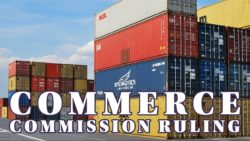
3-minute read
False import charges have become an endemic issue in the local freight forwarding industry with only a limited number of operators excluded from the practice, according to a stakeholder who approached the Shipping Gazette™ following last week’s article on the issue.
Compulsory Container Weighing Rules (Are You Ready?) 
3-minute read
Did you know that the IMO (International Maritime Organization) passed an amendment to SOLAS (Safety of Life at Sea) requiring verification of container weights?
How to Reduce Your Import Charges (One Simple Step!) 
2-minute read
The message is loud and clear from the buyer (importer) to request all applicable destination charges from the China supplier upfront.
New Rules in Trans-Tasman Trade (What You Need to Know) 
2-minute read
A trans-Tasman customs mutual recognition agreement (MRA.) due to come into force by June next year will lessen border checks and speed the movement of export products to market for members of the two countries supply chain security programmes.
Reasons for Delay in MPI Bio-Security Applications 
2-minute read
The Ministry for Primary Industries (MPI) has advised us of seasonally high volumes in bio-security applications.
You Won’t Believe How Much Cash NZ Customs Dogs Find Per Year 
2-minute read
A recent recruit to our Detector Dogs team, Kane, a black Labrador, has been proving his worth at the border.
How to Avoid Buying Fake Goods – and What will Happen to It 
3-minute read
Fake goods are easily accessible everywhere these days – international travel and online shopping make it easy for people to buy counterfeits and import them. You can be almost certain that Prada in a plastic bag at a night market is unlikely to be the real thing.
Can You Reduce Value of The Goods and Minimise Import Taxes? 
3-minute read
If you import goods into New Zealand you must declare the Customs value of the goods on the import entry or clearance document, but questions are always asked – how is the value determined, and what is the process for appeal?
Importer: New Rule for Hazardous Substances (You have 30 Days) 
3-minute read
Most businesses that make or import hazardous substances have to give some basic contact information to Environmental Protection Authority (EPA).
Are You Responsible for New Cargo Weighing Requirements? 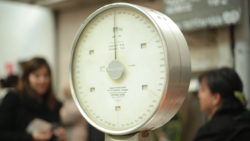
2-minute read
Global Shippers’ Forum (GSF) Secretary-General Chris Welsh was in New Zealand recently, attending the NZ Shippers’ Council annual meeting and also for comprehensive meetings with Government officials.
Why Coastal Shipping is Important for NZ Shippers 
2-minute read
New Zealand’s coastal shipping sector needs to be acknowledged as a valuable transport asset that figures prominently in future transport planning, according to both the New Zealand Shipping Federation and Customs Brokers’ and Freight Forwarders’ Federation (CBAFF).
How to Get a New FernMark – and Receive Instant Credibility 
3-minute read
A new FernMark, embedded with augmented reality and including a global trademark monitoring programme, is now available to help exporters market their products internationally.
Do not Miss Canton Import and Export Fair (3 Practical Tips) 
2-minute read (3-minute watch)
One of the globe’s great trade fairs will commence in Guangzhou province, in southern China, and according to the representative of the China Foreign Trade Centre it will be one of the biggest yet.
Why is Your Shipment Delayed? (How to Avoid Common Issues) 
3-minute read
Many importers and exporters question why does it take so long to go through the New Zealand border? Easy Freight has received the following update from MPI (Ministry for Primary Industries). Unfortunately, it happens several times a year and it is not an isolated case. Therefore, we recommend that you send documents to your Customs broker at least 2-3 weeks before it arrives in New Zealand.
How does Trans Pacific Partnership (TPP) Affect You and NZ 
2-minute read
Negotiations for the Trans Pacific Partnership (TPP) Agreement have been successfully concluded. It involves 12 Asia-Pacific countries, which together account for 36 percent of the world’s economy.
This agreement will deliver significant benefits to New Zealand – it will support more jobs, higher incomes, and provide a better standard of living for New Zealanders.
You’re Paying False Import Charges and Don’t Even Know That 
6-minute read
Recent complaints made by importers against several freight forwarder charges are disturbing. It shows that there is a structural problem in the way importers are doing business, and a lack of clarity as to what ‘rules’ apply.
Should New Zealanders Fund Rail and Road? 
5-minute read
Is it time to radically change our thinking in terms of rail? Should we stop expecting a financial profit from the rail, and start to recognise its more strategic importance in our national transport infrastructure?
5 Aspects of a Perfect Import Business (Number 3 is a Gem!) 
4-minute read
Our job is to cut costs and save time for importers and exporters. We would like to share some of the insider secrets with you.
What Problems to Expect When Exporting to China (And How to Avoid Them) 
3-minute read
“It is highly recommended that all companies do their due diligence before committing to the overseas market”. This was the main message from Mr Paul Smith, NZ Customs Counsellor.
The Do’s and Don’ts When Working with an Overseas Supplier 
4-minute read
Interview with Aaron Muir from Argus Tracking. Aaron Muir is a director of Auckland-based firm Argus Tracking, which has had its asset management hardware manufactured in multiple countries.
2 Shocking Facts You Need to Know About Imported Flowers 
2-minute read
The New Zealand Flower Growers Association (NZFGA) wants imported flowers to be labelled as imports so consumers can make an informed choice about whether to buy them.
How to Import a Car and Avoid Costly Mistakes 
3-minute read
New Zealand has quite an old vehicle fleet compared to many other countries. The average age of a car is about 13 years.
Why Do Shipowners Have a Limit on Compensations? 
6-minute read
Politics involves a heap of misleading information. The tendency is to seize on populist themes and fashion statements that meet with approval over the dinner table, in smoko rooms and in the pub.
How to Import Building Materials Duty-Free 
2-minute read
Most residential building materials can now be imported into New Zealand duty-free as a result of a new tariff concession scheme recently announced by the Government.
Can You Really Trust Parallel Imported Goods in New Zealand? 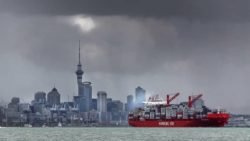
3-minute read
Parallel imported goods are genuine branded products that are imported into New Zealand (or other countries) and sold within that market without the brand’s owner consent.
9 Surprising Facts About the Worldwide Shipping Industry 
3-minute read
How do the goods of the world travel from one place to another? Despite technological advancements and the propagation of a globalized economy, a surprising 90% of everything still comes and goes on a ship by sea.
How to Find an Overseas Supplier for Your Product Idea 
3-minute read
Finding the right supplier for your product idea may prove challenging. If possible, you should find one that you like working with, and they should also provide you with a quality product at a fair price.
Here are the steps involved in finding a supplier, and some of the many considerations you will have to navigate along the way.
What does Asia’s Rise Mean for Your NZ Company? 
3-minute read
The IMF (International Monetary Fund) data indicate a continued rise in the proportion of the global GDP accounted for by Asia. The Asian region almost doubles in importance in the 40-year period to 2020, rising from 18.3 percent of the global economy in 1980 to 30.8 percent in 2020.
5 Rules That Could Impact Your New Zealand Importing 
3-minute read
There are several rules that could impact your importing, and it is vital to know what procedures you need to follow in order to ensure timely and safe delivery of your goods.
[True Story] Is Your Marine Insurance a Waste of Money? ![[True Story] Is Your Marine Insurance a Waste of Money](https://easyfreight.co.nz/wp-content/uploads/2016/06/True-Story-Is-Your-Marine-Insurance-a-Waste-of-Money_-250x141.jpg)
5-minute read
There are some harsh lessons sometimes handed out in business. A good case was reported in the Shipping Gazette™ of a cargo owner with a shipment on board the ill-fated cargo vessel Rena.
To pay for the freight of a consignment of export goods from Napier port that gets as far as the Bay of Plenty and ends up on the seafloor, seems to incur a triple slap in the face.
Importing Into NZ? Have You Considered These 6 Risks? 
4-minute read
Thinking about importing goods into NZ? Perhaps you can access better prices or superior quality overseas? Or maybe you’ve identified a market for goods that just can’t be sourced locally?
But importing into NZ is more complicated than it may seem at first. The risks are significant if you don’t know what you’re doing. To give your venture the best chance of success, it’s best to learn the risks before you start such business.
BEWARE: NZ Importers Targeted by Email Hacking Scam – 5 Ways to Control It 
2-minute read
A dangerous and highly effective new online scam is affecting New Zealand importers. The scam has already left several Kiwi businesses severely out of pocket, with some businesses losing deposits of over USD 250,000 to scammers.
Cargo Insurance: The Shocking Truth for Importers & Exporters 
4-minute read
As an importer or exporter, you’re no doubt always on the lookout for ways to save your money. But there’s one place you shouldn’t be skimping on, and that’s cargo insurance.
How to Import Household Goods — The Ultimate Guide 
5-minute read 3
Our clients often ask us about the goods that are restricted for importing to New Zealand. Can one bring necessary medicine, favourite DVD collection or some rare artwork as an unaccompanied baggage?
Why is Customs Holding Your Parcel? (and How to Avoid It) 
2-minute read 2 (4-minute watch)
International Postal Regulations require that every item passing an international border is subject to Customs inspection in the destination country.
Importers: Beware of ‘Fake’ Import Charges 
3-minute read
Importers to New Zealand need to beware of a legal ‘loophole’ that leaves you exposed to unexpected and unwarranted charges on your imported goods.
When you buy goods overseas under cost and freight rate (CFR) terms (see our Incoterms page for more about this), this should mean the seller covers the costs of freight to you in New Zealand.
But in some recent cases, importers have been hit with extra charges when their goods arrive, leaving them out of pocket.
25% of Courier Parcels Evade NZ Import Duty 
2-minute read
With the rise of internet shopping more and more New Zealanders are importing goods from overseas using postal and international courier services.
Tips on Importing Goods Into New Zealand 
4-minute read
This information is to help people understand the collection of Customs tariff duties, plus goods and services tax (GST), on articles imported into New Zealand.
It explains how Customs tariff duty is charged on goods imported into New Zealand, lists a number of concessions, and describes which goods are subject to strict import control, or are absolutely prohibited.
Demurrage and Detention: A Complete Comparison 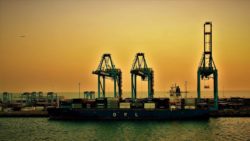
3-minute read
People often get confused by these two words Demurrage and Detention. Well then, what is the difference? When dealt with in the context of containerised cargo, simply put,
- Demurrage relates to container storage at terminal (charged by the port)
- Detention relates to container usage (charged by the shipping line)
Be Smart, Defer Payment to Customs 
6-minute read
THE MAIN ADVANTAGES TO IMPORTERS ARE:
- Deferral of the payment of Customs charges for up to seven weeks, with a minimum period of three weeks.
- No requirement to pay cash on each import entry. Instead, importers have an account with Customs and settle one month’s transactions with a single payment.
Your Expectations from Us 
2-minute read
Easy Freight has responsibility in making sure your orders not only head to the destination in good condition but actually go through customs border without delay.
How to Get Paid 
4-minute read
Both buyers and sellers need to determine the risk to their own business, the amount they are willing to pay to mitigate that risk. There are four commonly used payment methods for reducing these risks.






























































































































































































































































































![[True Story] Is Your Marine Insurance a Waste of Money](https://easyfreight.co.nz/wp-content/uploads/2016/06/True-Story-Is-Your-Marine-Insurance-a-Waste-of-Money_-250x141.jpg)











